Greek foods
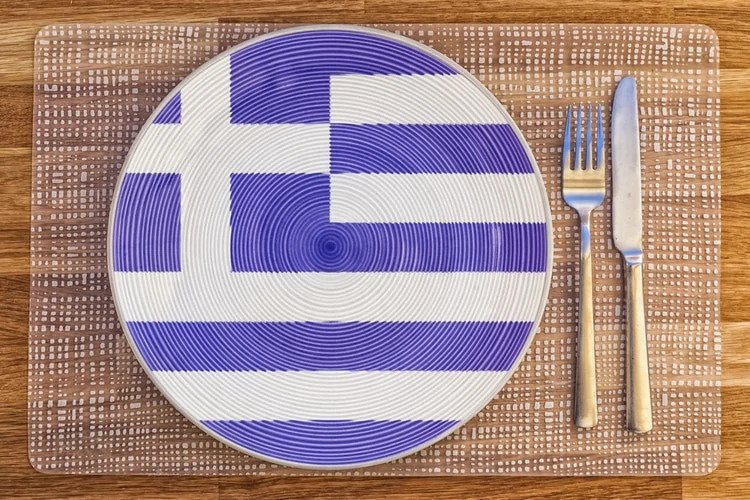
From ancient times till the modern-day era, there is nothing better than fresh Mediterranean Greek Food.
Those are the iconic dishes You have to try !!!!
Dolmakadia
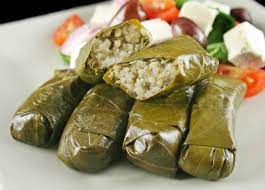
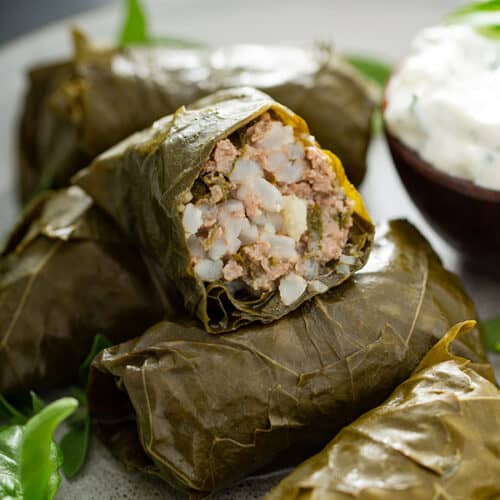
This tasty dish is made of stuffed grape leaves. Dolmakadia are tiny dolmades with lamb or beef, mint, and rice. It’s usually served as an appetizer. Love those
Tzatziki
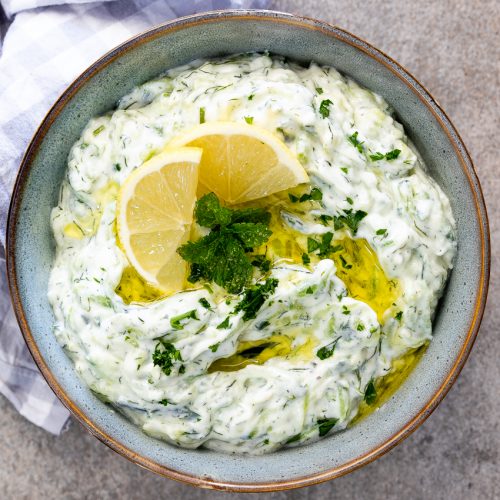
The wonderful tzatziki sauce that goes perfectly almost with everything in Greece. It is made from Greek yogurt, cucumber, fresh Dill, and garlic is one of the Greek foods everyone should try at least once in their life.
Avgolemono
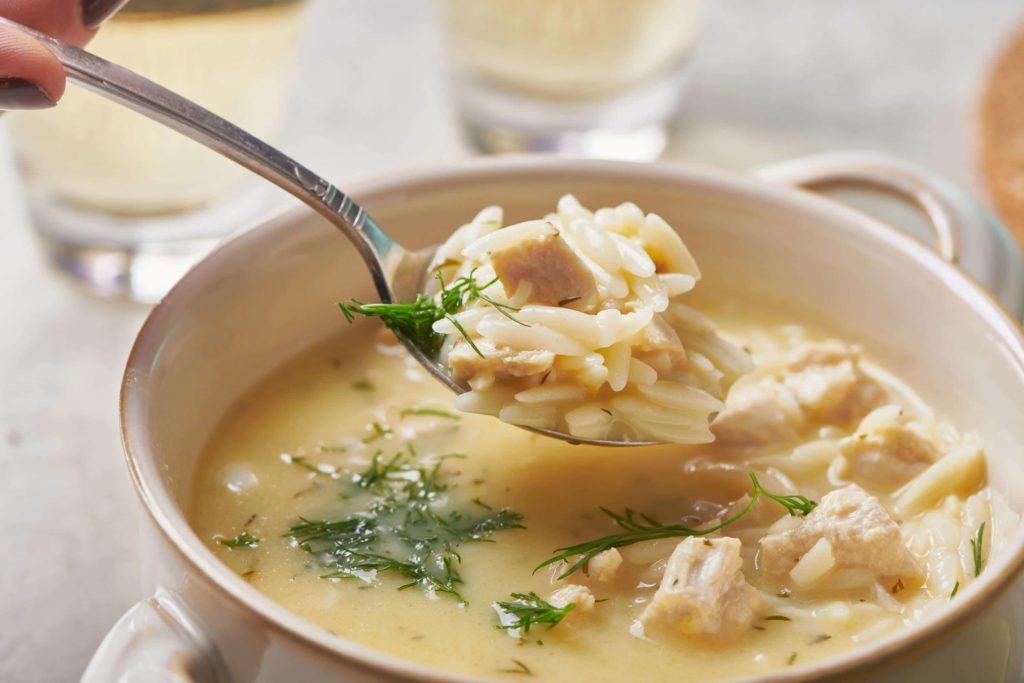
A silky chicken broth soup made with lemon juice, rice, and whisked eggs. It’s usually served with some lamb meat or chicken as well and topped with pepper to add more flavor. Definitely one of my favorites.
Spanakopita
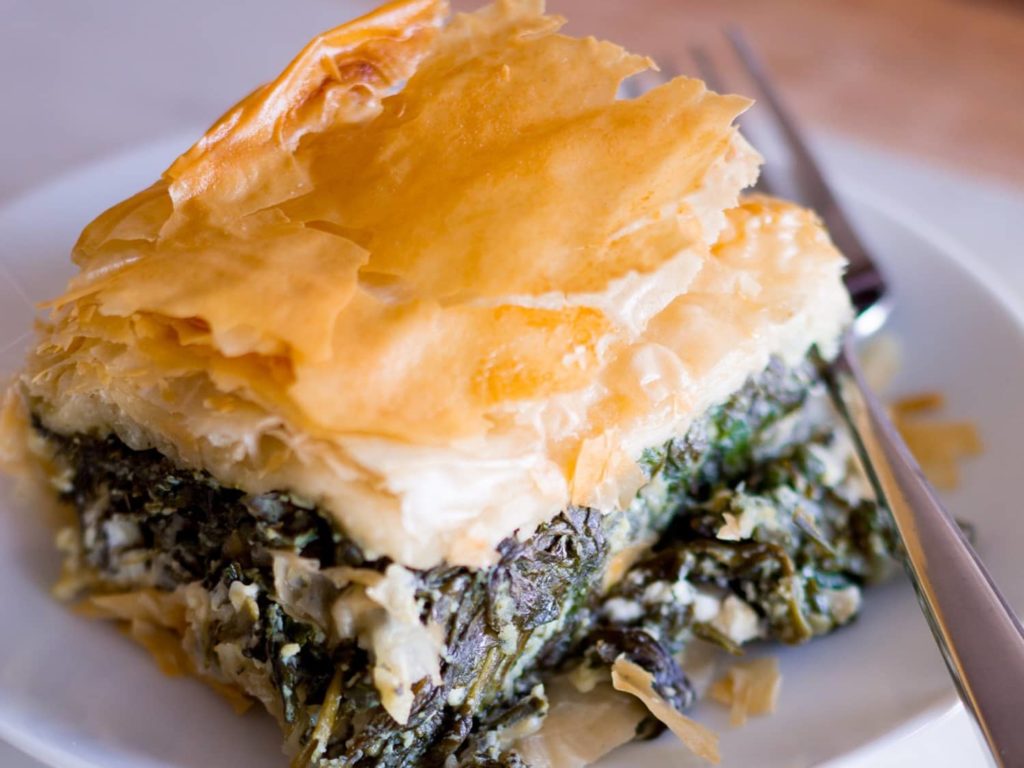
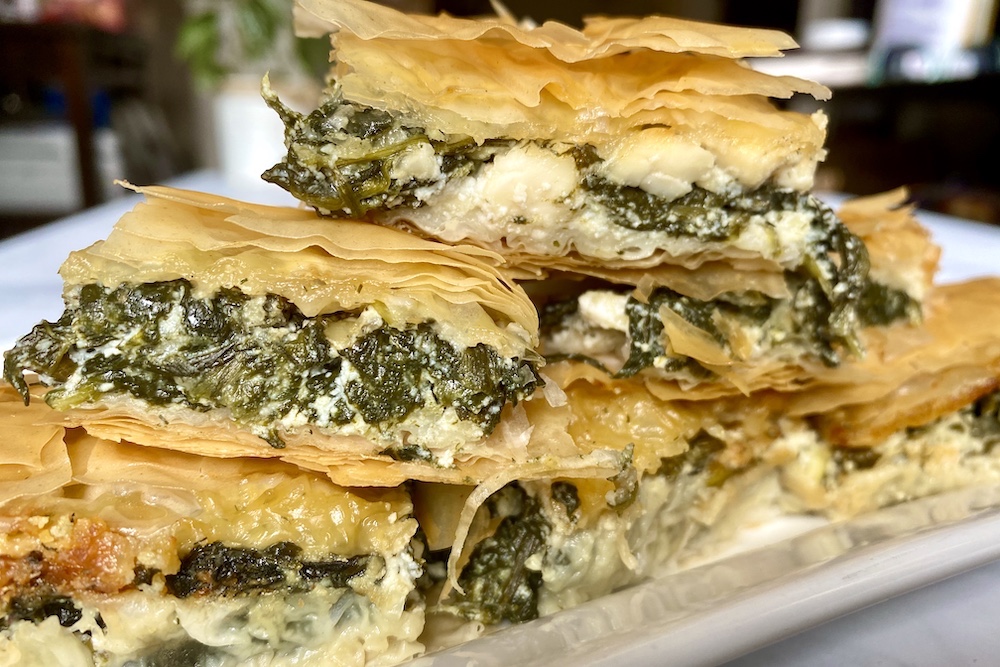
A spinach pie with feta cheese, onions or scallions, and egg. The filling is wrapped in phyllo (filo) dough. Spanakopita is delicious and it’s perfect as a snack or side dish. It is delicious hot, straight from the oven, or cold as a snack.
Taramasalata
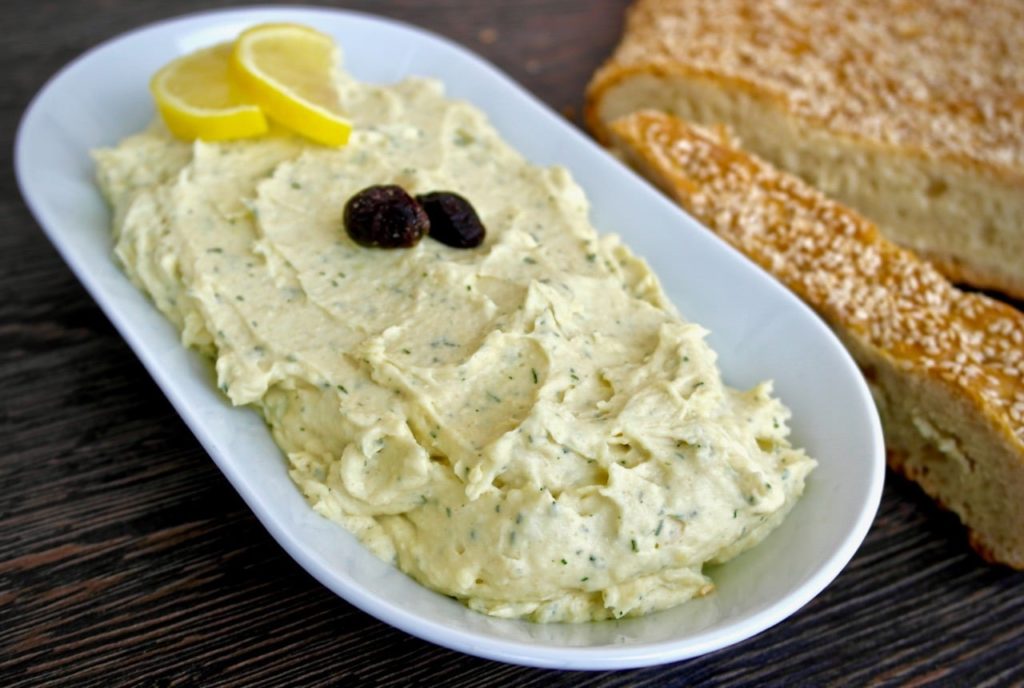
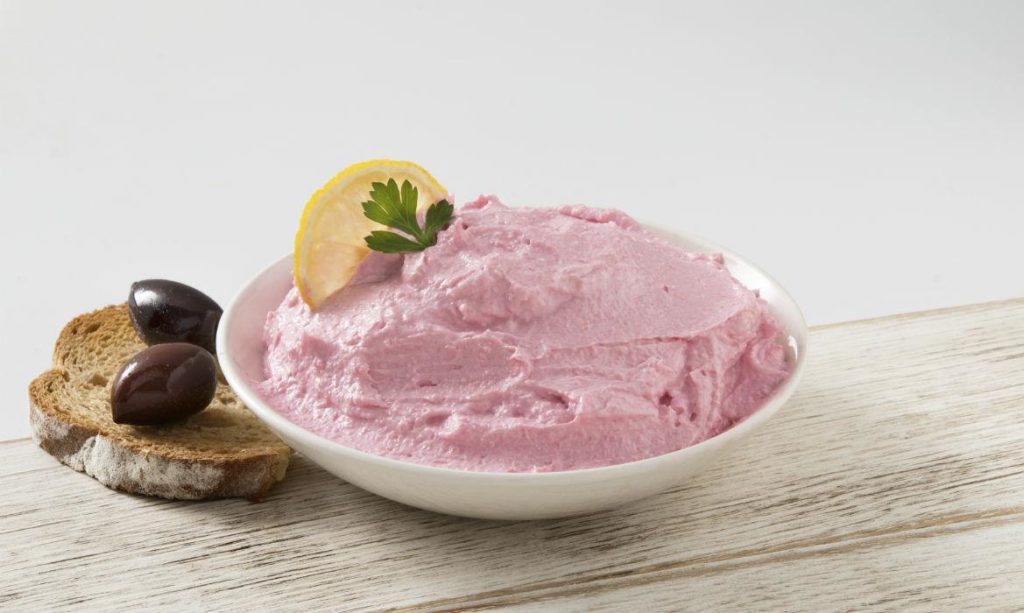
A spread made from fish roe that’s usually served as a meze and a dip for bread or vegetables. Recognizable by its pinky color. In Greece, Taramasalata is especially associated with the first day of Great Lent.
Moussaka
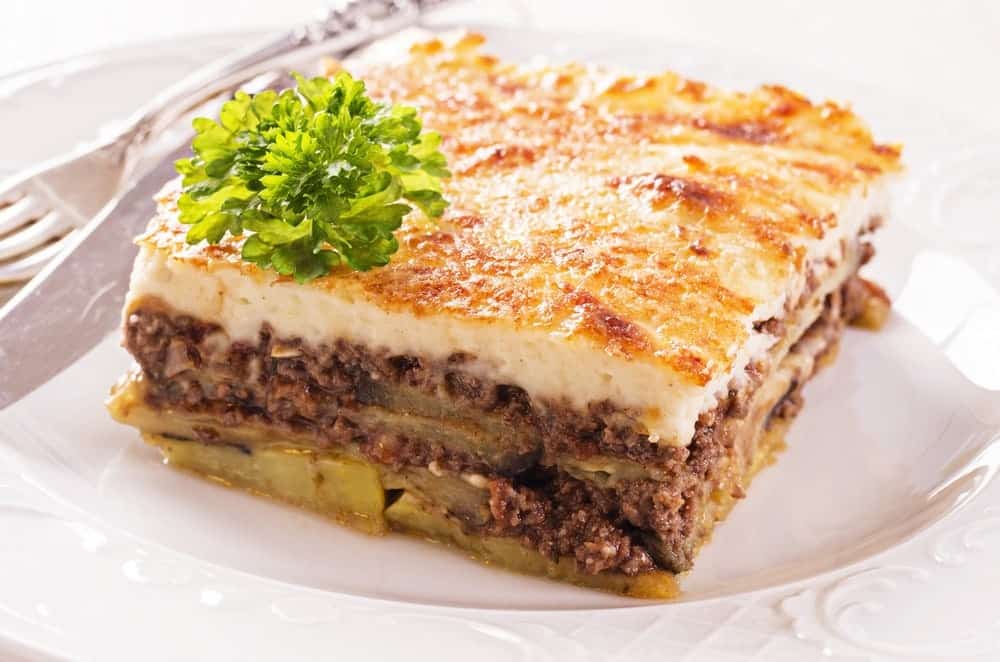
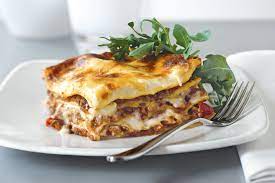
Moussaka is one of the national dishes of Greece. It’s definitely one of the Greek foods everyone should eat at least once in their life!
There are lots of variations of Moussaka, when almost every family has its own recipe. The traditional Moussaka recipe consists of sauteed eggplant, tomato, ground lamb, a layer of potatoes, and a final fluffy topping of cheese and béchamel sauce. However, a lot of modern versions use ground beef without potatoes. Moussaka can also be made vegetarian for non-meat eaters.
Kolokythokeftedes
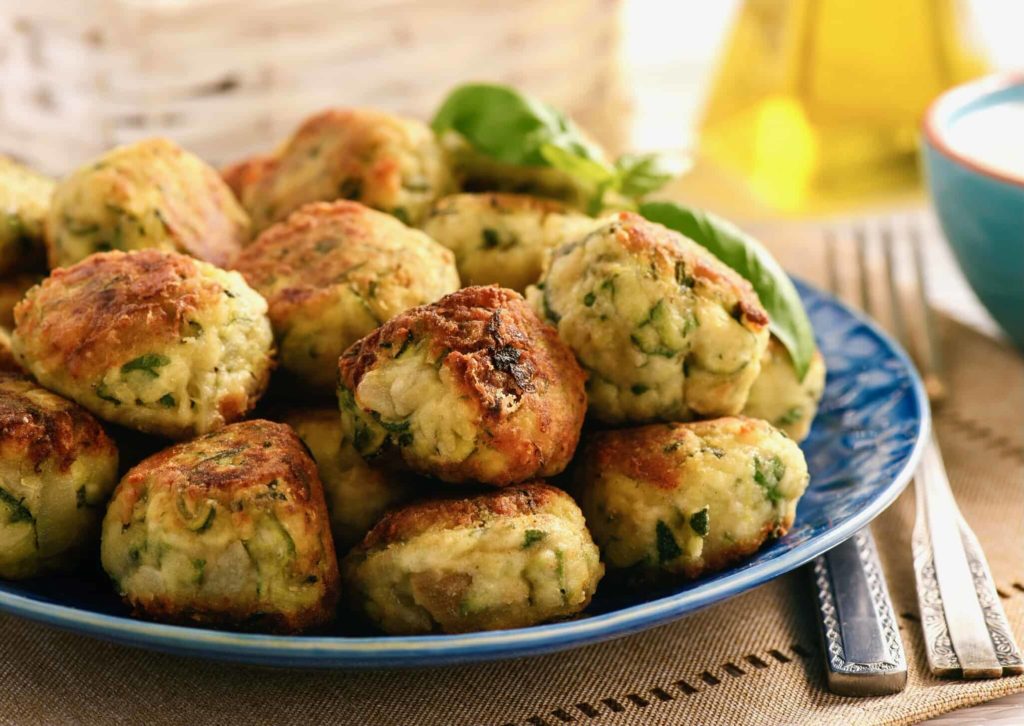
This is a very popular Cretan meze, found in most (if not all) Greek restaurants. This Greek zucchini fritters recipe is easy to make and super delicious. These yummy fried zucchini fritters are made with fresh zucchini, amazing herbs, and are fried lightly until golden brown. Your taste buds will be charmed by its flavored texture, salty & tasty feta cheese with a bit of fresh mint. The original kolokythokeftedes must be crispy on the outside with a creamy texture on the inside.
Feta
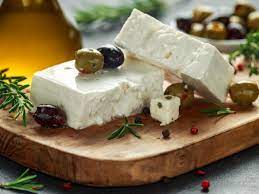
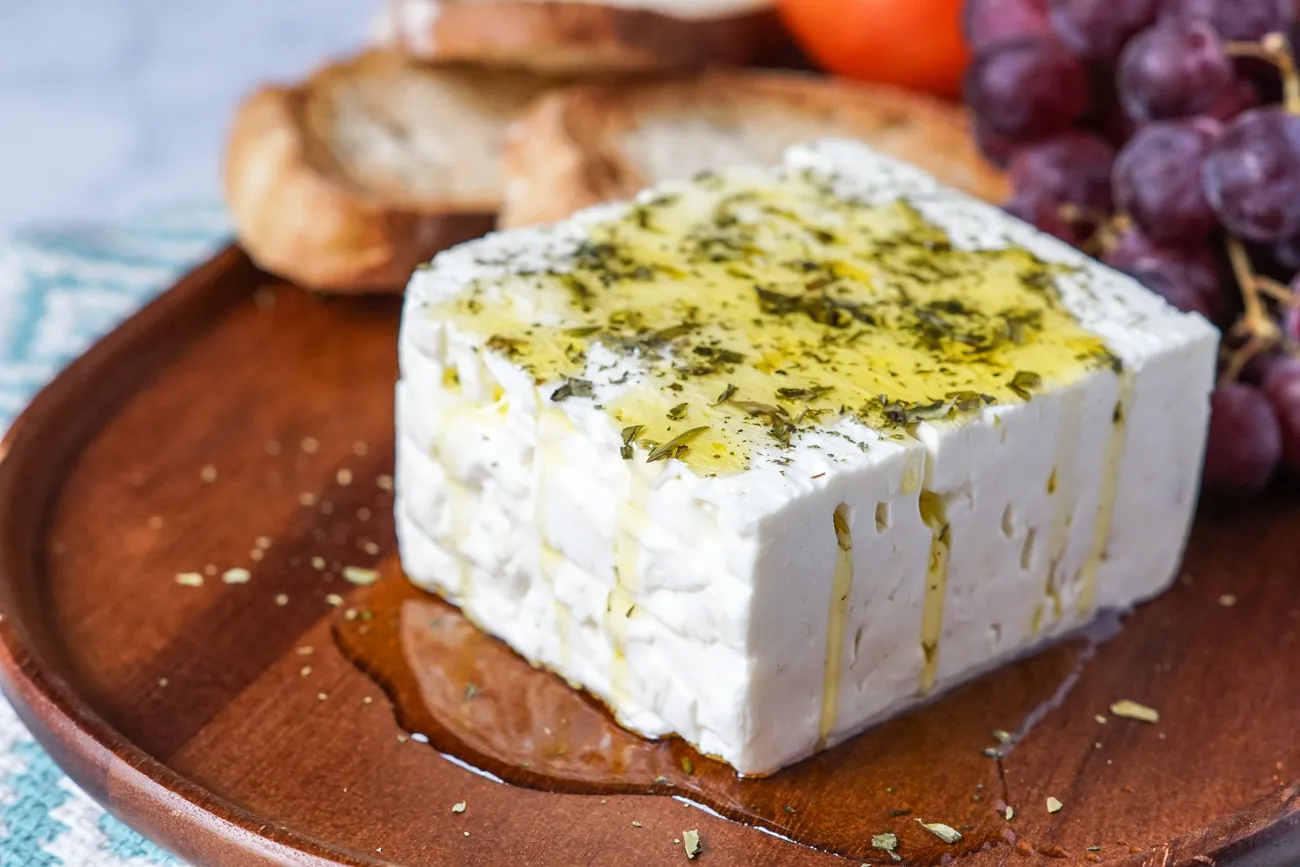
The quintessential Greek cheese. Yes, there are many imitators but there is only one feta. Feta has a tangy, rich, and slightly salty flavor. Feta is a brined cheese (it is placed in a brine solution) that is made either only from sheep’s milk or a combination of sheep and goat milk. It is aged in the brine minimally 2 months, but the good feta will be aged 12 months.
Baklava
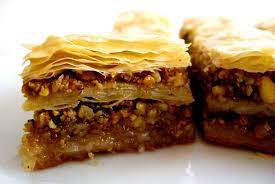
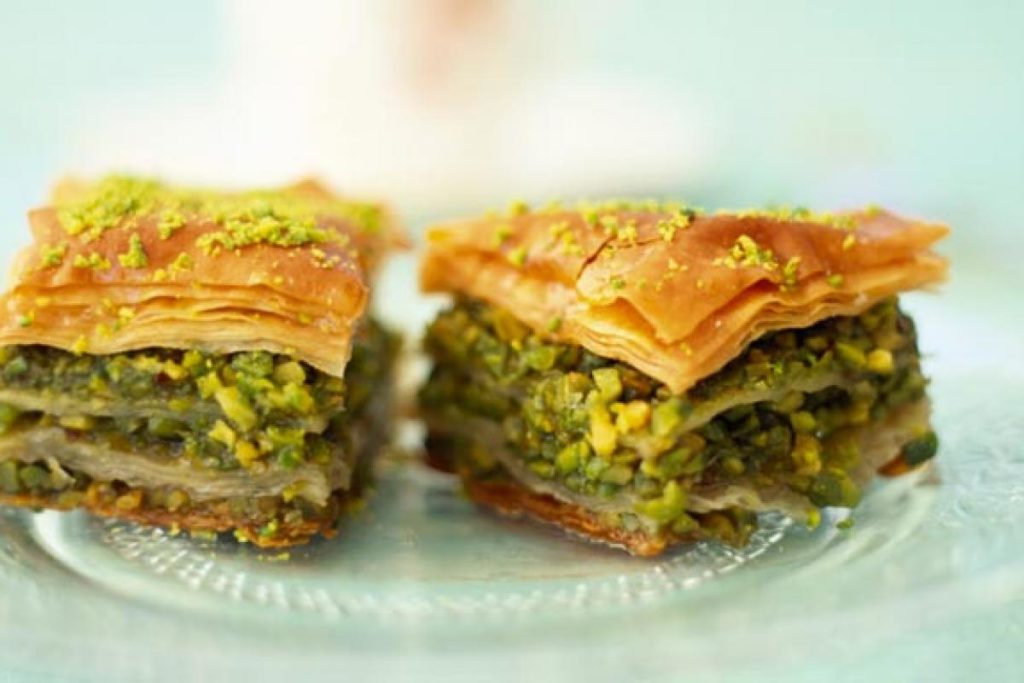
Baklava is the quintessential Greek food experience. Baklava is one of the classic Greek renditions of the Turkish dessert. It’s made with multiple layers of phyllo pastry, all spread with melted butter and a light layer of nuts, either pistachios or walnuts. The best part of this dessert is the silky cinnamon-orange syrup that is poured over it once it is baked.
In some regions, baklava is cut in rhombus shapes and a single clove is placed on top of each one to further enhance the deep flavors. Being buttery and comforting, it is mostly served in the winter.
Papoutsakia
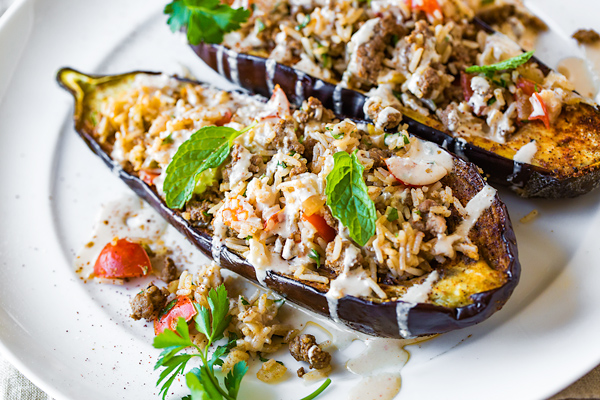
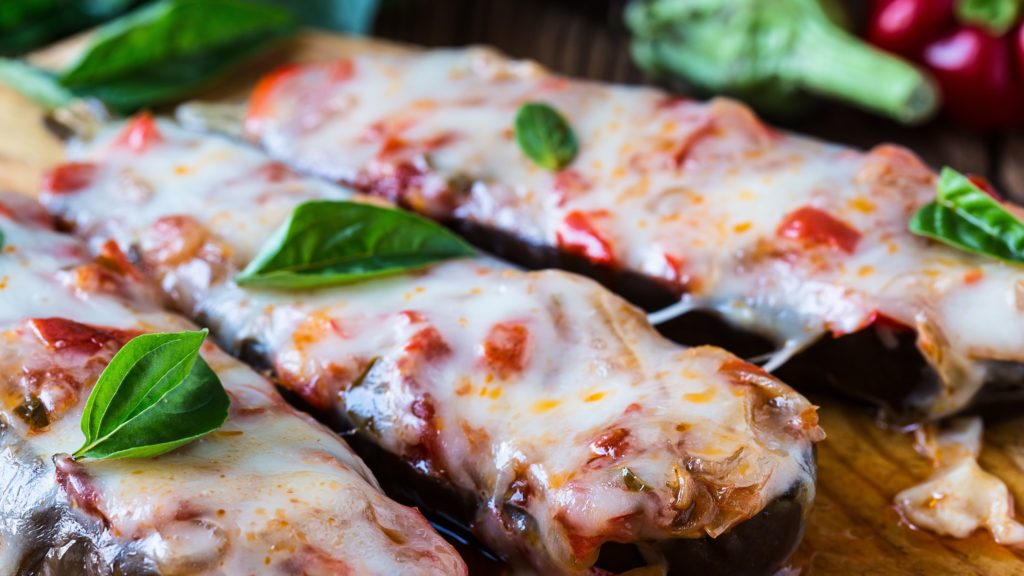
Papoutsakia means shoes in the Greek language, and it’s a true classic in the Greek kitchen. Papoutsakia is stuffed eggplants that are usually filled with seasoned ground veal and tomatoes and bechamel sauce. The dish ingredients are very similar to Moussaka dish.
Pastitsio
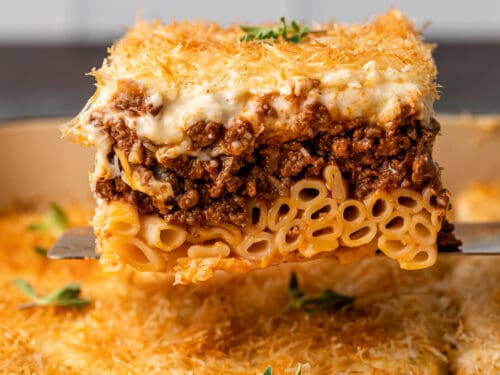
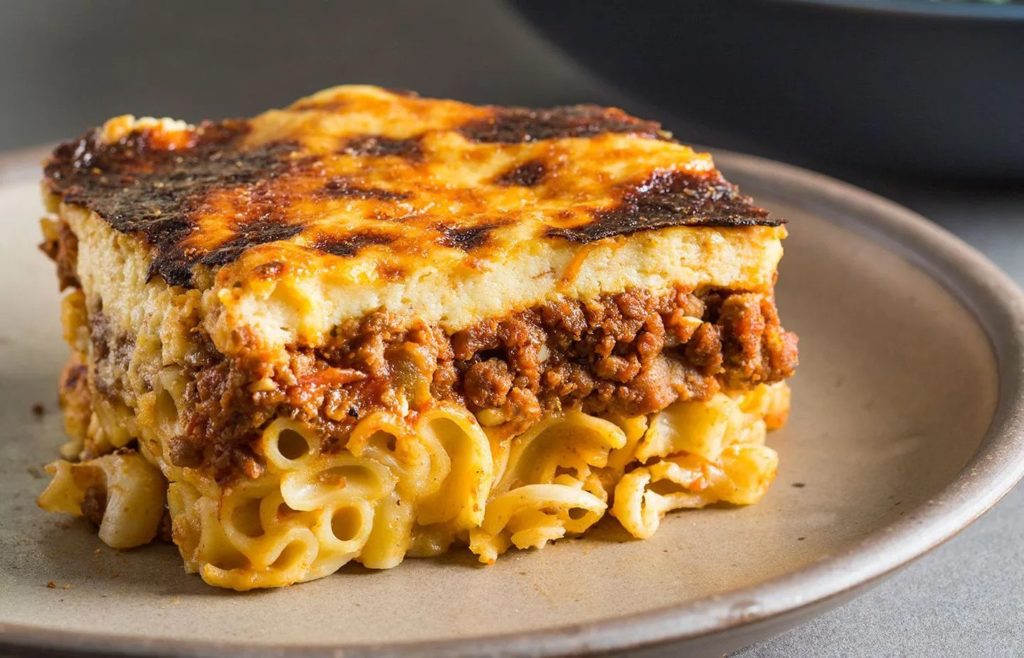
A baked pasta dish with bechamel sauce and ground beef. This Greek dish is being eaten year-round and it can be described as the Greek version of Lasagne. It’s also one of the dishes that the ancient Greeks ate, and there’s proof that Pastitsio was eaten as early as 1200 B.C.
Souvlaki
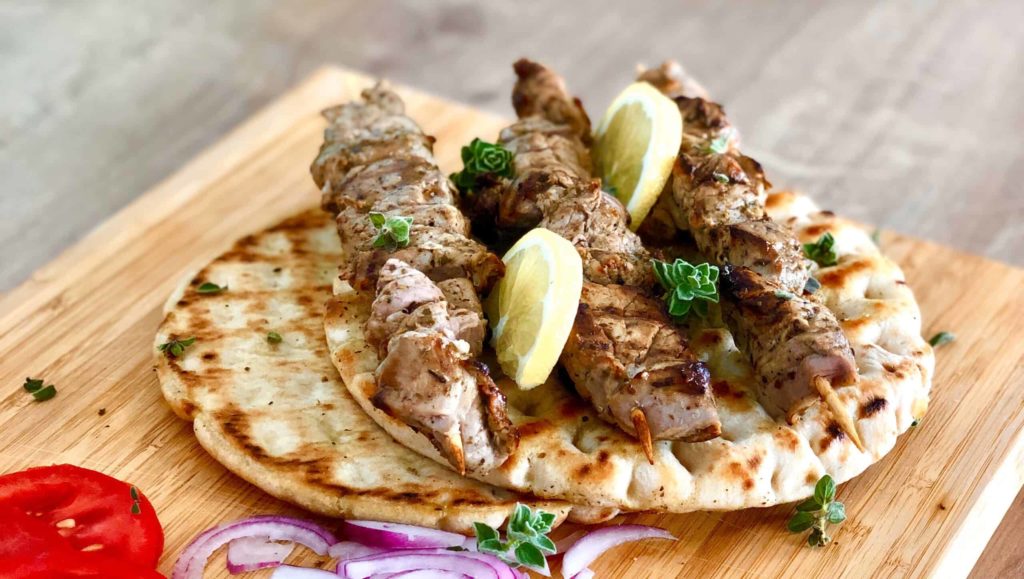
Another traditional Greek food is the Souvlaki, which you can find in almost any Greek restaurant. Souvlaki is a very popular Greek food available in street side restaurants. The dish is well cooked with seasoned meat and then flavored with tzatziki sauce. In Greek language Souvlaki stands for ‘meat-on-a-skewer. Souvlaki is basically grilled meat on a skewer and can be everything from pork, chicken, lamb, beef, and vegetables. It usually comes with some side veggies and fries, tzatziki, and pita bread.
Soutzoukakia Smyrneika
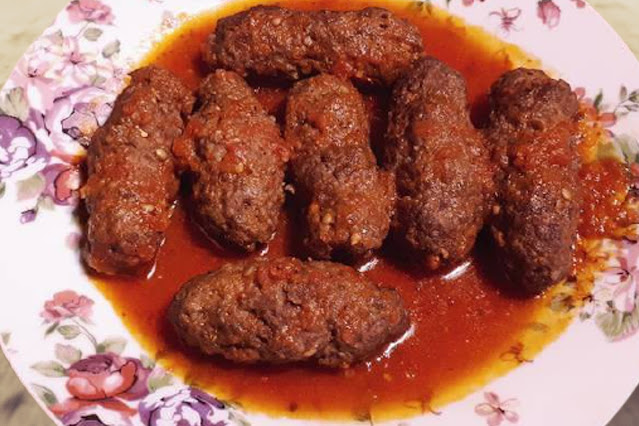
Smyrna meatballs, known also as İzmir köfte (Turkish) is a Greek and Turkish dish of spicy oblong meatballs with cumin and garlic served in tomato sauce. This dish was brought to Greece by refugees from Asia Minor. The Greek version is typically made with minced meat (usually beef, also mixed with lamb or pork), bread crumbs, egg, garlic, and parsley, and generously spiced with cumin, cinnamon, salt, and pepper. They are floured before being fried in olive oil. The tomato sauce has tomato, wine, onion, garlic, a bay leaf, salt and pepper, and olive oil. Soutzoukakia are generally served with pilaf or mashed potatoes.
Giouvetsi
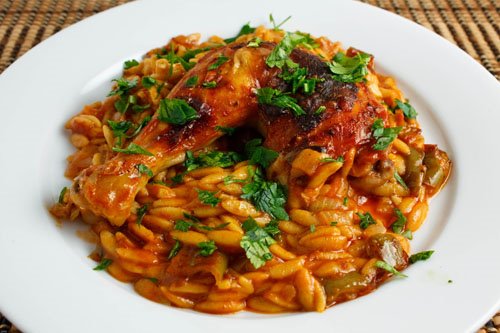
Beef Stew with Orzo Pasta. The Greek Giouvetsi is made with orzo pasta, onions, red wine, delicious tomato sauce, and beef. It makes for a perfect Sunday family dish!
Stifado
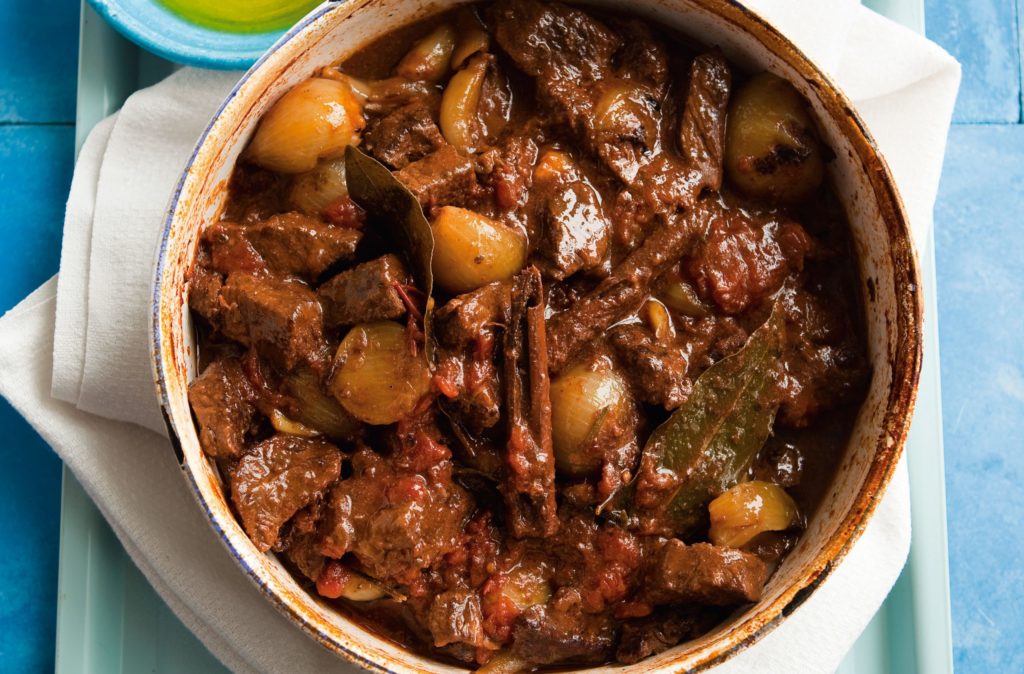
A traditional Greek meat-stew with onions, tomato, wine or vinegar, and a variety of spices – it’s often characterized by cinnamon and tomato. The stifado is usually made on the stovetop but can also be made in the oven. The older recipes of Stifado don’t include tomatoes though since they didn’t arrive in Europe until later.
Tomatokeftedes
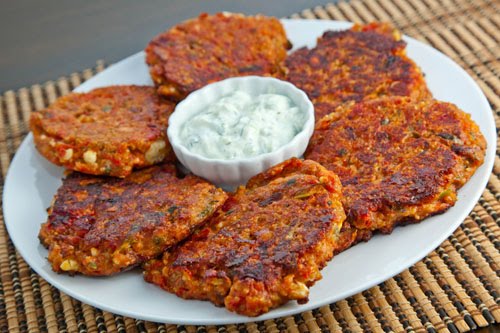
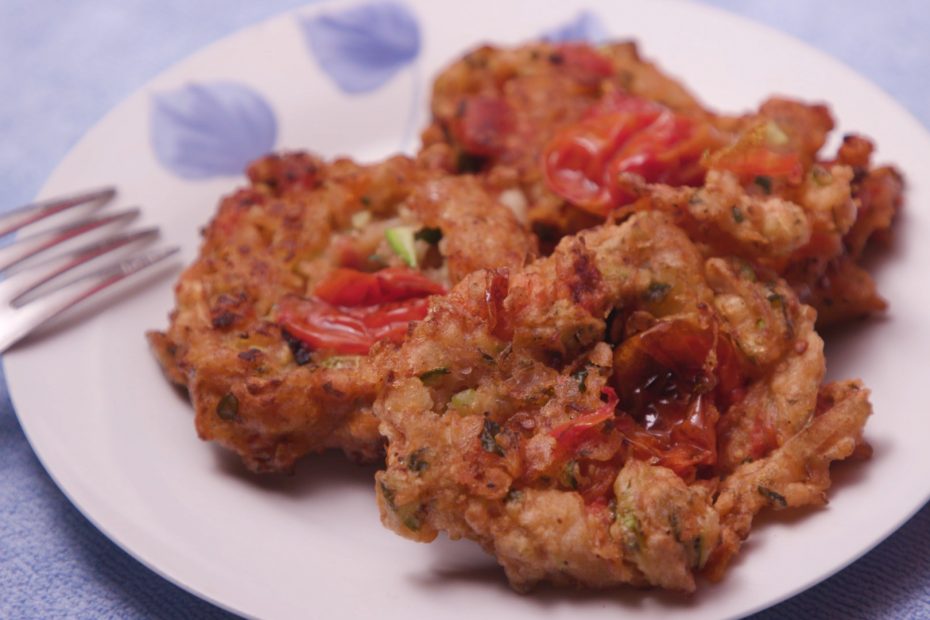
or tomato fritters are traditional meze and main course vegetarian food items in Santorini and Syros. Proper draining of tomato is essential for preparing this delicious food item. These fritters have rough edges with bits of mint, tomato, and onion chunks.
Choriatiki/Horiatiki
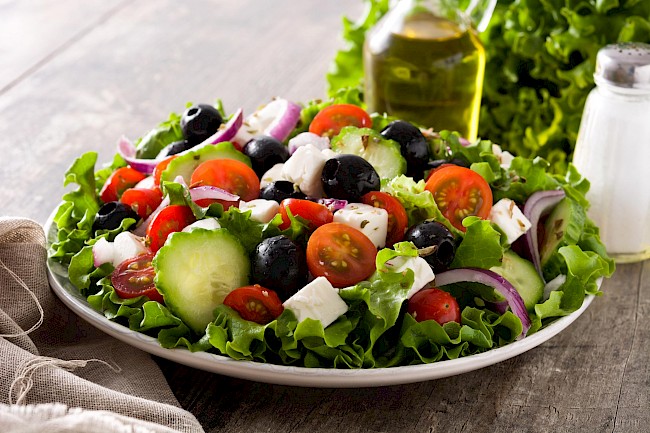
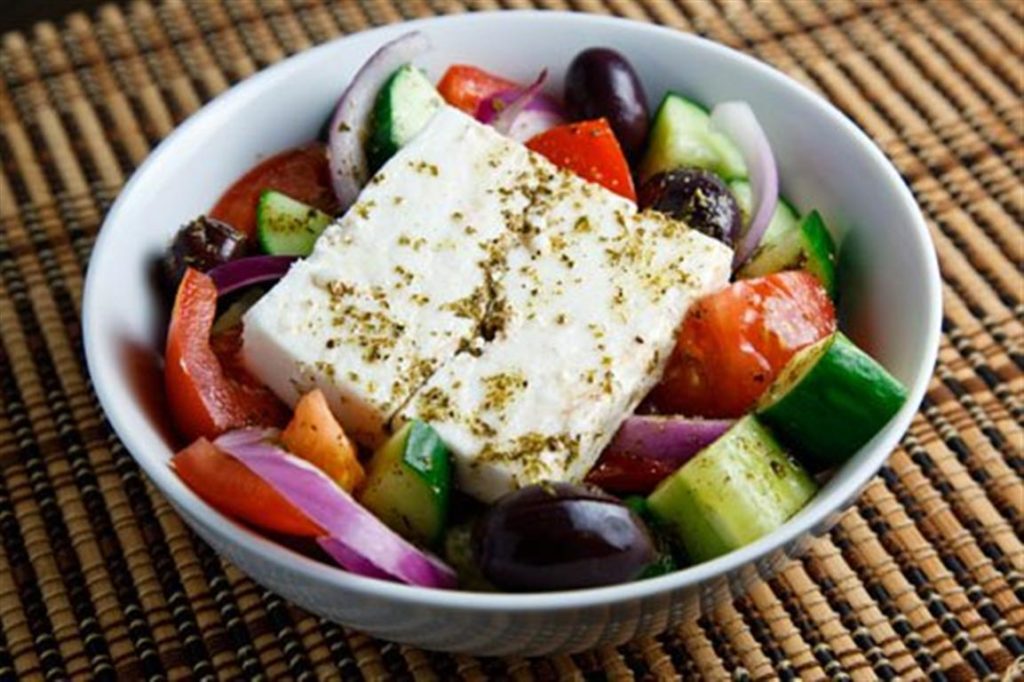
Greek Salad. One of the most beloved Greek dishes. It’s simple, fresh, and available everywhere in Greece. Some regions and islands will have their own versions of salad.
Ellinikos

Ellinikos is still the favorite style of coffee adopted in Greece. The coffee is served in the traditional long handled coffee copper pot which is known as briki in Greek. There are three different tastes of Ellinikos like Vari Glyko which mean strong & almost honey-sweet, Metrios meaning medium sweetness, and Sketos meaning without sugar.
Kleftiko
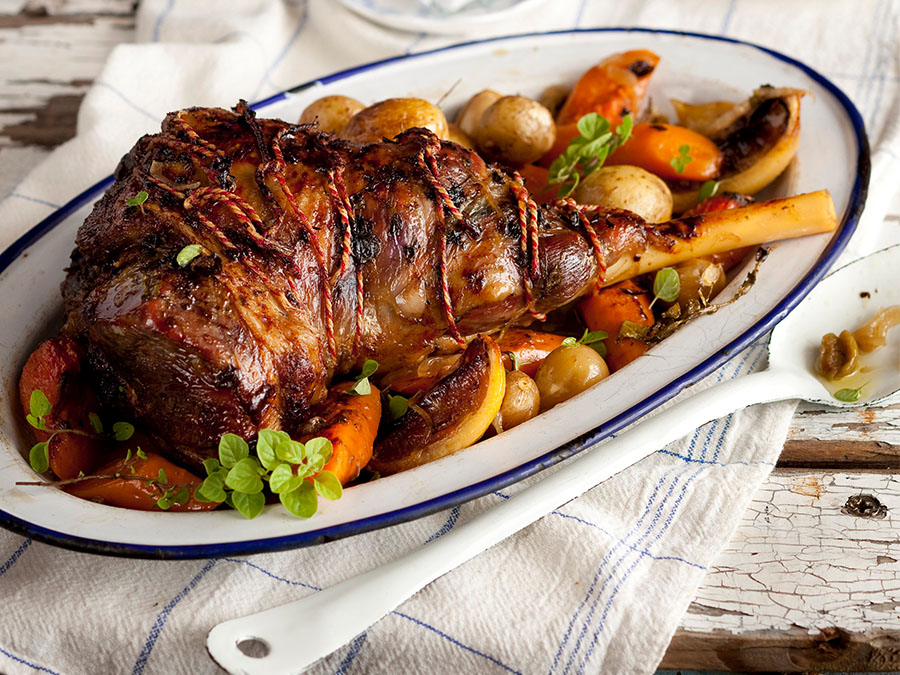
Lamb is a specialty in Greece. Kleftiko was originally cooked in an earth oven, which is a small pit in the ground, used to trap heat and smoke. It’s a truly traditional Greek dish with slow-oven-baked lamb on the bone, which is first marinated in garlic and lemon juice.
Genista or Yemista
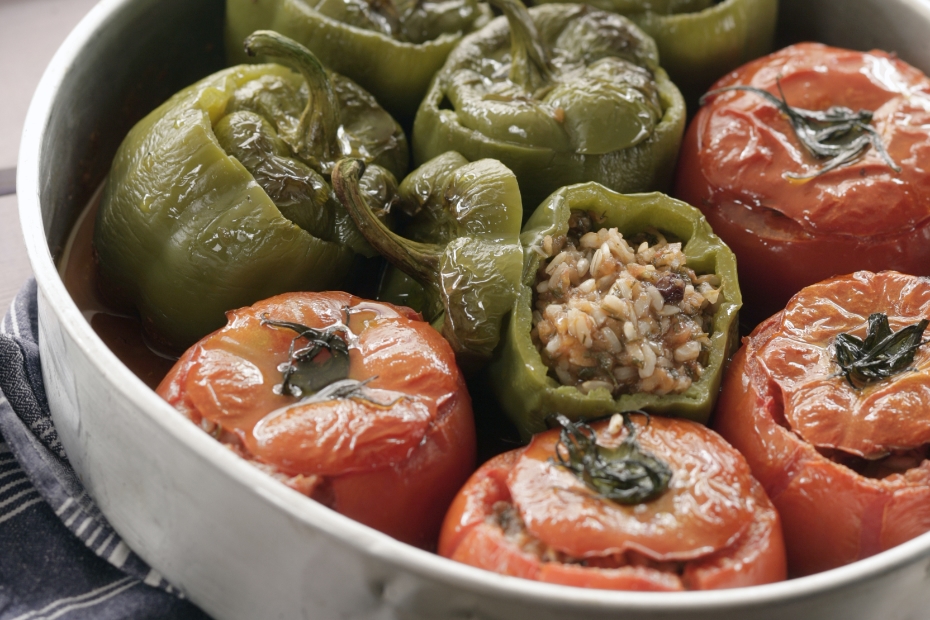
Stuffed tomatoes and peppers with rice and herbs but could also include minced meat. There are many different recipes for Yemista, and they can be seasoned with different spices and herbs in order to get a unique flavor.
Fasolatha
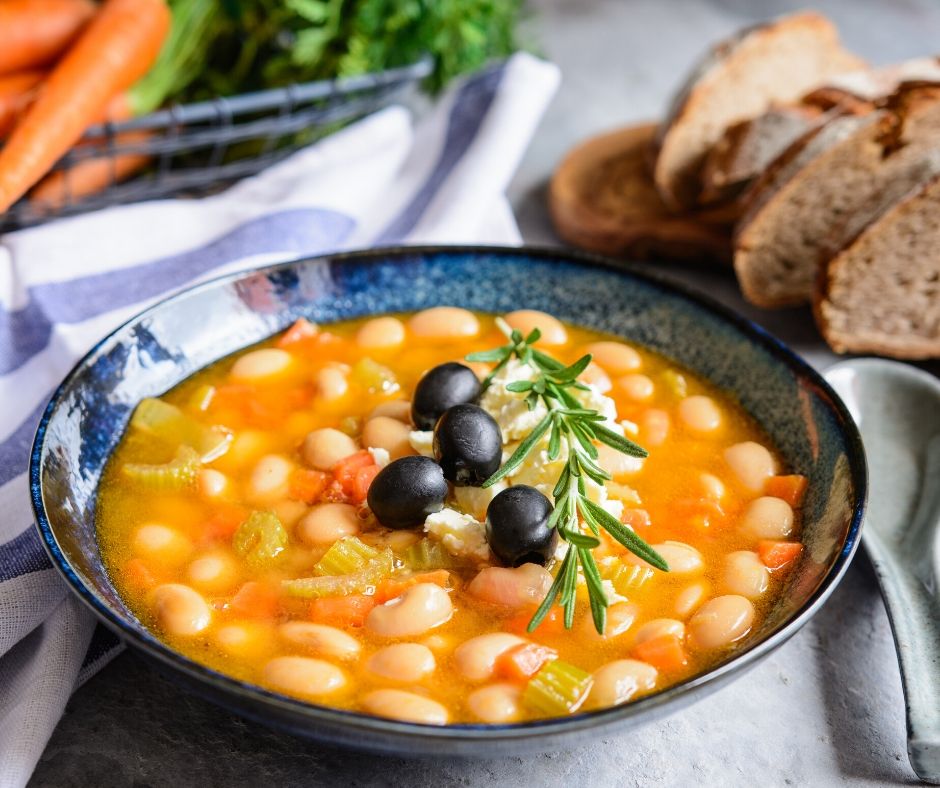
Although not so well known internationally, another traditional Greek dish, is this simple and hearty white bean soup called Fasolatha. The recipe consists of beans, crushed tomatoes, carrots, celery, and onion. It’s often flavored with bay leaves, parsley, and thyme.
Bougasta
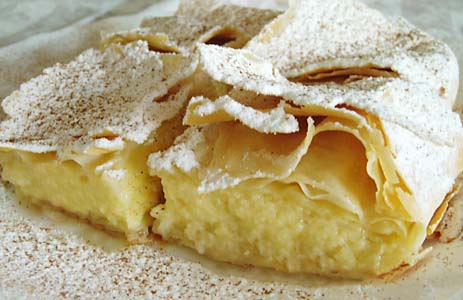
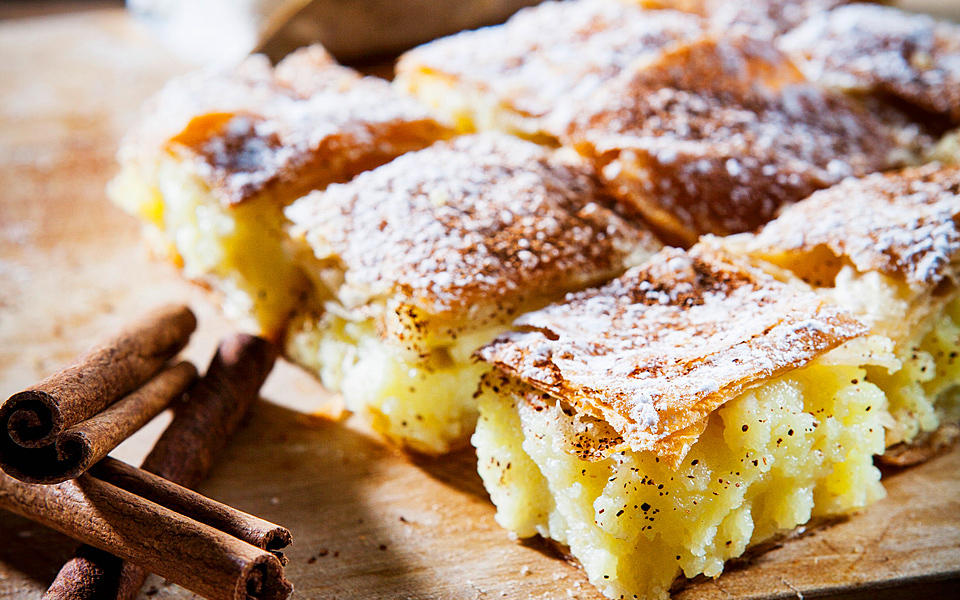
Bougasta is a kind of sweet pie (less sweet if you consider Greek standard) made of phyllo pastry & semolina custard. This is a kind of food that tastes good in the daytime, delicious at late night, and best enjoyed with pleasant memories. If you want to eat this pie from the roadside food court you will also get a sprinkle of powder sugar and cinnamon on top.
Tiropita
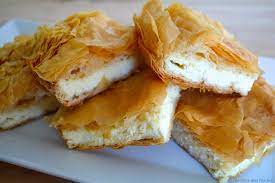

Tiropita, otherwise known as “Greek cheese pie”, is traditionally popular throughout Greece and can be eaten as a starter or a mid-day snack. This feta cheese food comes into different shapes & sizes. When it is rolled into individual triangular servings that’s when it is called Tiropita.
The main ingredient used in this recipe is various types of cheese (feta cheese mostly). Melted butter and olive oil are also used while preparing this mouthwatering dish.
Horta
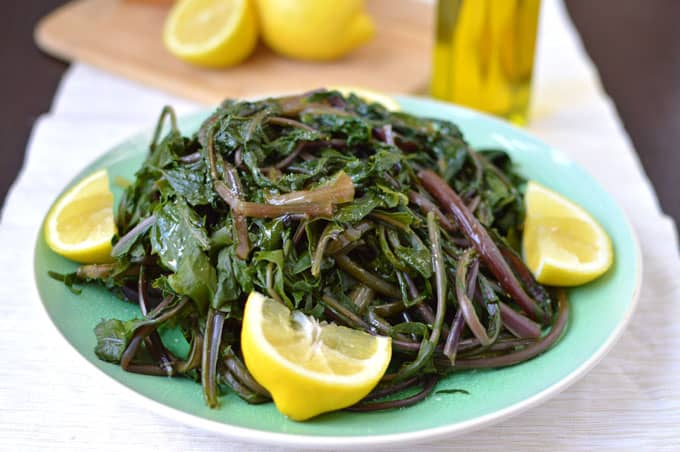
Leafy Boiled Greens. Horta is the classic vegetable dish in Greece that consists of lightly-boiled leafy greens, including vleeta, chicory, dandelion, or mustard, seasoned and served with lemon or vinegar and olive oil.
Briam
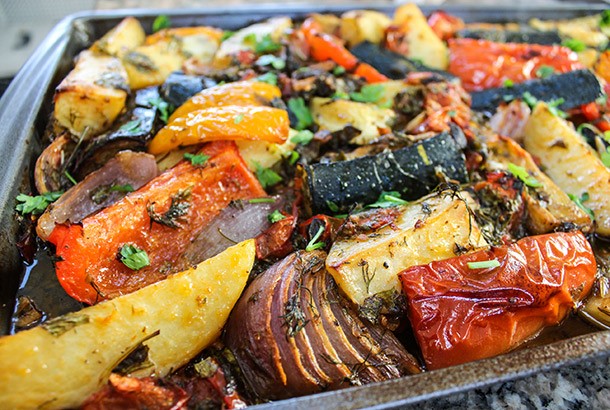
Roasted Vegetables. Briam is an all-vegetable dish (perfect for vegetarians) that consists of zucchini, eggplant, and potato mixed with tomato sauce and garnished with oregano. The vegetables are flavored with garlic and onions, coated with olive oil, and then baked to create a tasty Mediterranean flavored dish.
Saganaki
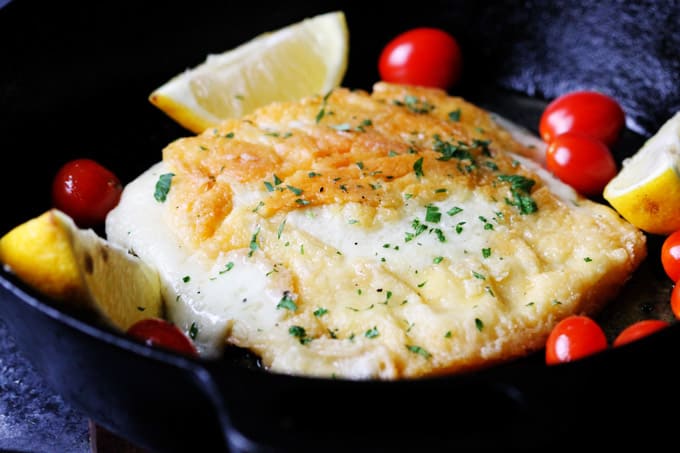
Saganaki is actually the name for all small dishes that are being fried in the small pan called Saganaki. But the most common one is the Cheese Saganaki or Shrimp Saganaki. Either way, the gooey, melty cheese with a crispy golden crust is one of the dishes to die for. The cheeses which are used in Greece to make traditional Greek saganaki are graviera, kefalograviera, and kefalotyri. They are all medium hardness yellow cheeses with a mild nutty flavor. If you can find one of these at your local deli, go for it! You will also find regional variations which may use Cypriot halloumi or mastello from the island of Chios.
Gigantes
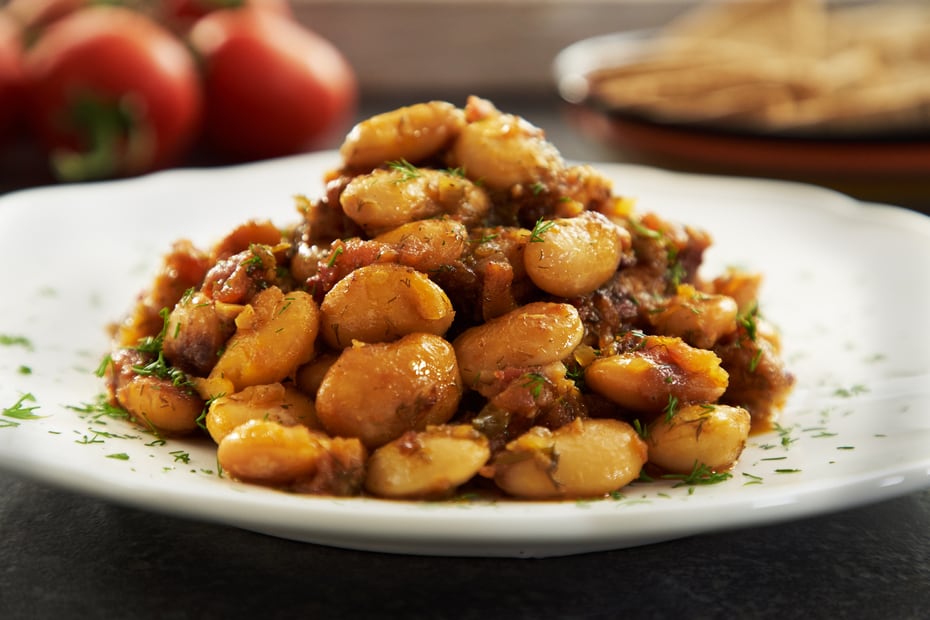
Giant Beans. A very enjoyable and healthy meal, Gigantes are giant beans baked in tomato sauce and fresh herbs. Often times they are garnished with crumbled feta cheese, but even without any topping at all, they are not to be missed!
Amygdalota
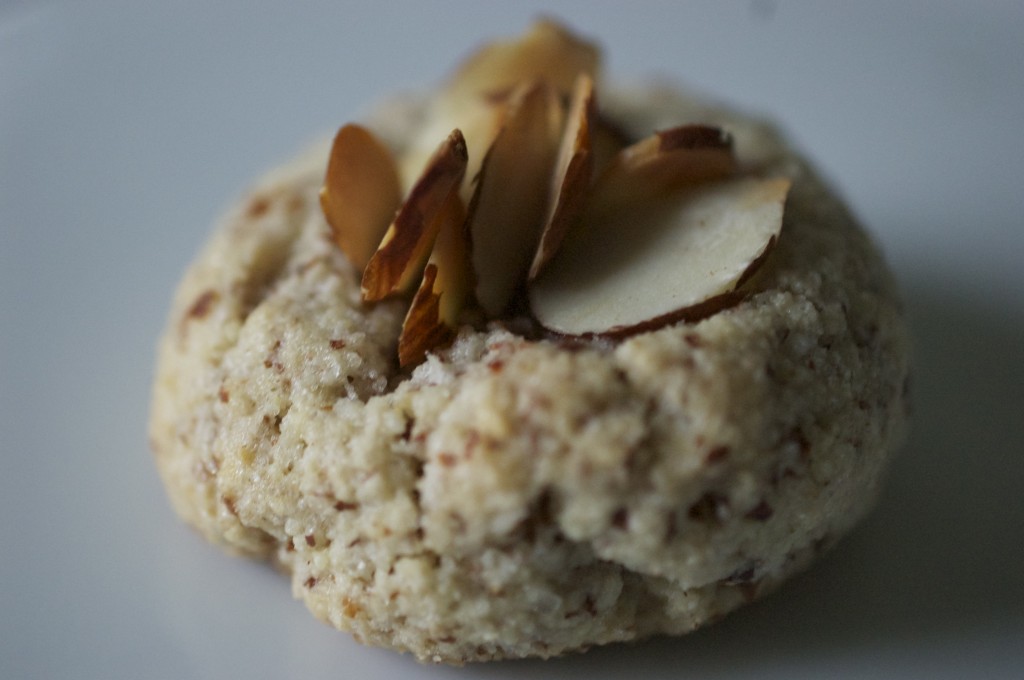
Amygdalota isa gluten-free almond cookie that is wildly popular in Greece and is the perfect match to a warm cup of Greek coffee. Whether it is a family or friends gathering, Amygdalota reflects the images of good times warm relationships. This food may vary a bit in different parts of Greece, but almonds are the dominant ingredient throughout the regions.
Tirokroketes
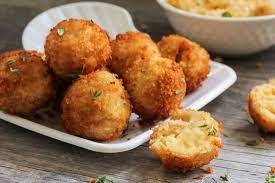
The fried cheese balls are a dish for all you cheese lovers out there. Usually eaten as an appetizer, these delicious small bites are made from a combination of various cheeses, graviera, feta, and gouda, which are then mixed with bread crumbs before being fried.
Tirokroketes are basically fried cheese balls. It’s a popular meze, and you can usually find these in any Greek taverna.
Revani
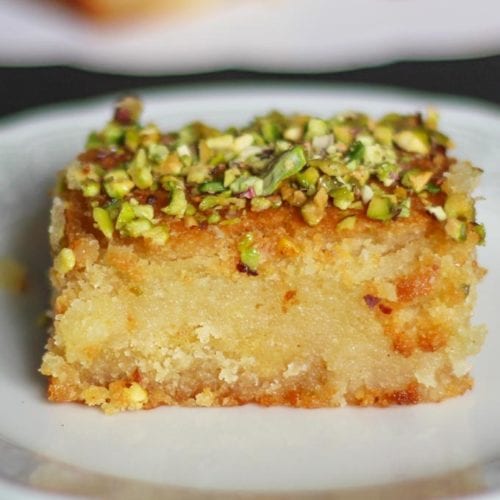
Revani is a very popular dessert that is nutty and grainy with some lemony flavor. This moist cake is sweetened by simple syrup flavored with orange zest. This is not an overly sweet dessert, and it is indeed a delightful addition to any dining table.
Feta Me Meli
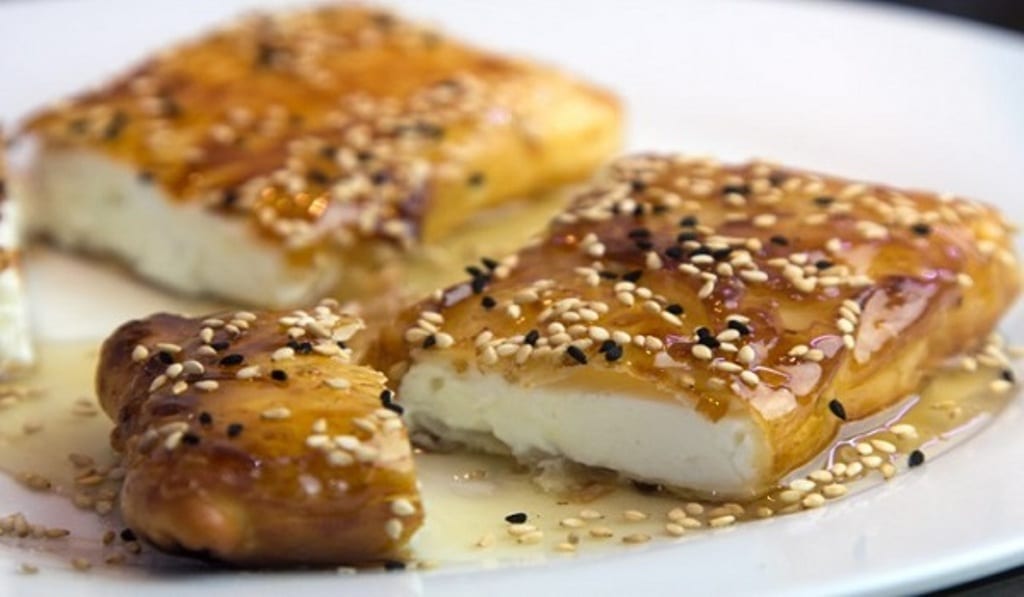
Another Greek food dish that can be tasted as a dessert or an entrée. Feta is wrapped in filo pastry before oven-baked and honey is drizzled over it. The optimum balance between salty feta and sweet honey creates a mesmerizing taste.
Frappe

Frappe is an iced coffee drink that makes your hot summer days comfortable. Two main components of Frappe are water and instant coffee granules. Once mixed it becomes addictive, delicious, and frothy. With such a strong appeal it’s a perfect pick-me-up drink without extra calories.
Galaktoboureko
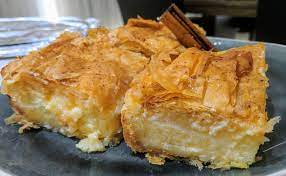
It is a great Greek dessert with crispy perfection. Take a mouthful bite of Galaktoboureko and let your mouth be filled with its juices. This age-old Greek dessert is made of crispy phyllo sprinkled with melted butter. Greeks use the most creamy custard & scented syrup to increase the taste of this food by many folds.
Ohtapodi me kofto makaronaki
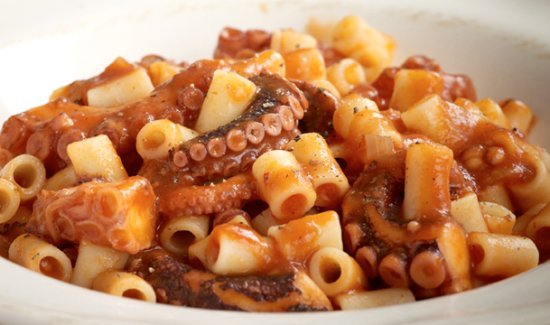
Octopus is also common in Greek cuisine, and there are many dishes with octopus. Some of the most popular ones include grilled fresh octopus and Octopus pasta. Braised octopus till tender and then grilled with olive oil for this specific char, on top of pasta. Just delicious.
Portokalopita
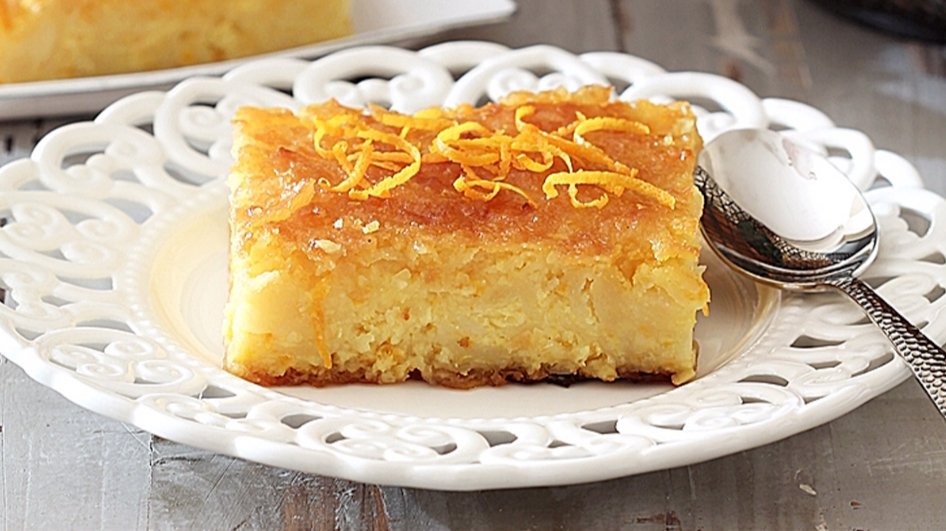
or orange pie is a very unique Greek dessert. Like many Greek desserts, the orange-flavored syrup is poured on top once the pie is out of the oven. It looks like a moist cake but is made with scrunched-up phyllo pastry, orange juice and zest, sugar, eggs, and milk. It’s usually served with either vanilla or mastic ice cream and orange spoon sweet. Since the pie is quite sweet, the ice cream complements the portokalopita perfectly.
Kataifi

This is one of the most popular Greek desserts made with a special type of pastry called Kataifi. When rolled up the pastry resembles shredded wheat. A delectable nutty center is rolled inside crisp, thread-like strands of pastry, baked, and then soaked in sweet syrup.
The pastry is full of strands so there is always a chance to get messy when you eat this. Except that purely delicious.
Keftethes
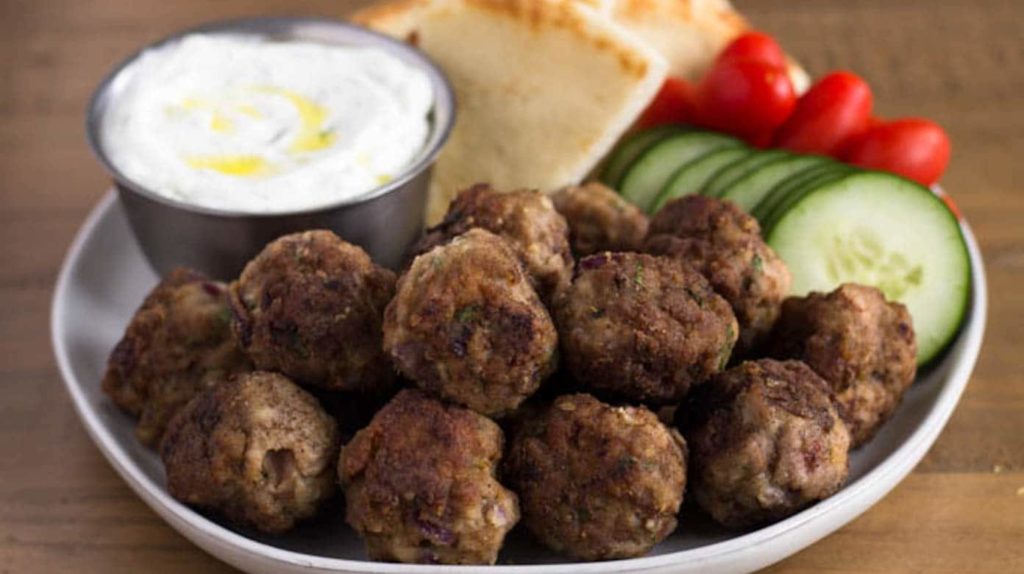
Give this juicy and crispy Greek meatball a try and bring a delicious twist to your plate. Keftethes is mainly a Greek appetizer dish served with creamy sauce and pita bread. Greek meatballs made of pork or beef and seasoned with oregano, onion, garlic, and a pinch of cinnamon. You will find Keftethes on the table on most festive occasions in Greece. This dish can also be eaten as a full meal with basmati rice and Greek feta salad, or just a s a delicious and juicy snack.
Loukoumades
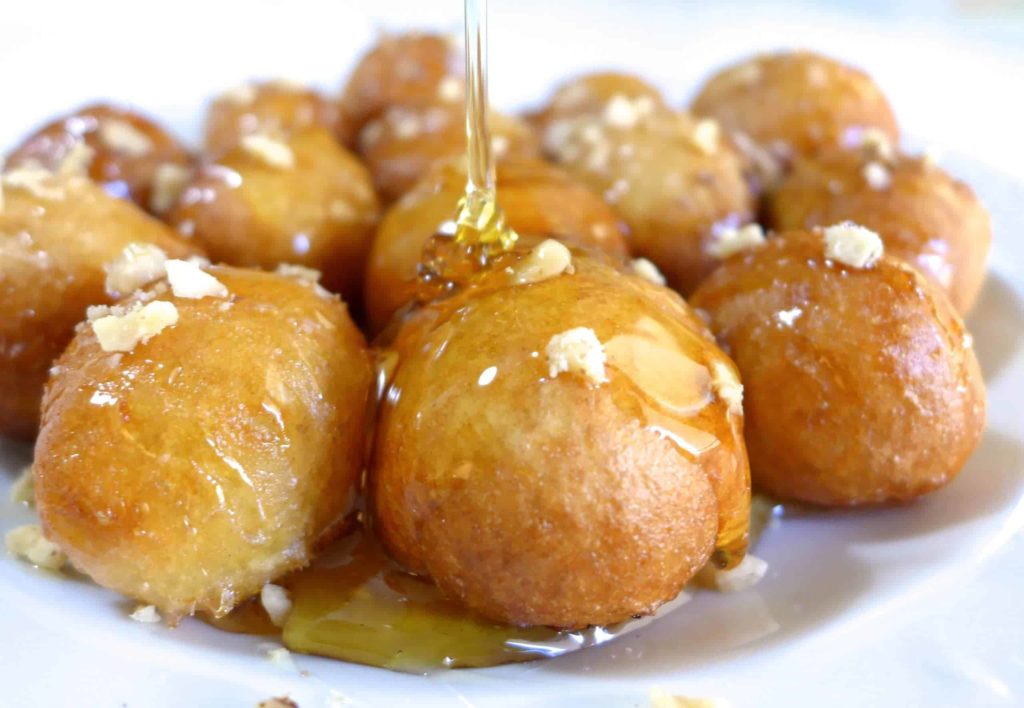
Loukoumades are little bite-sized golden puffs of fried dough that are sprinkled with sweet syrup, walnuts, and cinnamon. With a crispy outside and fluffy inside this Greek donut will give you absolute deliciousness.
These deep-fried “donuts” are poured with honey and sprinkled with cinnamon. Supposedly, in ancient Greece, they were served to Olympians. Fortunately, everyone can taste them now.
Pasteli
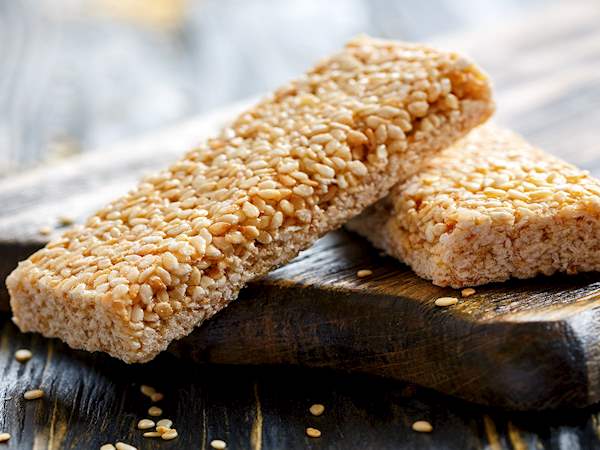
Pasteli is a Greek cuisine made of mainly two components; honey and sesame seeds. This pasteli are known as the original power bars in Greece. In addition to honey and sesame different nuts like walnuts, almonds or pistachios are used to bring more variety. Pasteli fits very well as an accompaniment to tea. It can also be eaten as candy or lunchtime snack and energy booster.
Halva
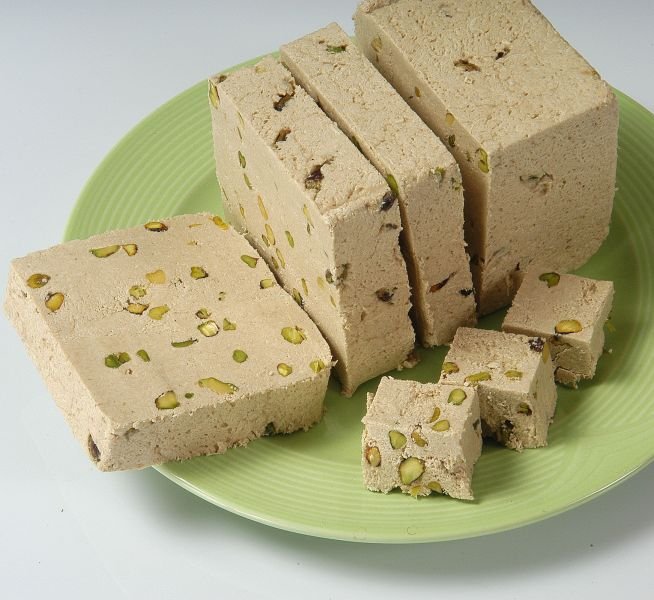
You will be astonished by the deliciousness of such humble food especially when you are looking for a no dairy, no butter, and an egg free dessert. Halva is a great combo of four ingredients: oil, semolina, sugar, and water. You will be captivated by the taste of these four ingredients when combined. In simple words, halva is semolina pudding which is sweetened by syrup and studded with nuts.
Yiaourti Me Meli
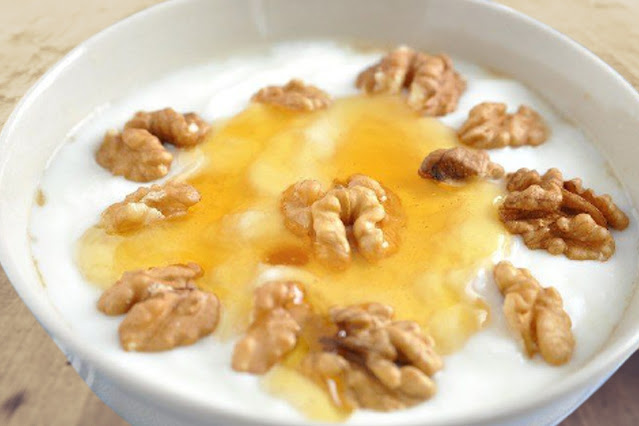
Yiaourti Me Meli literally means yogurt with honey. This is simple filler which is rich in protein with creamy sweet flavor. You can have this food in breakfast dishes or as a dessert. Yiaourti Me Meli is a healthy combo of Greek yogurt, honey, and walnuts.
The subtle sour taste of yogurt, the sweetness of thyme or wildflower honey, the depth & complexity of walnuts—altogether it is a food from heaven!
Gyros
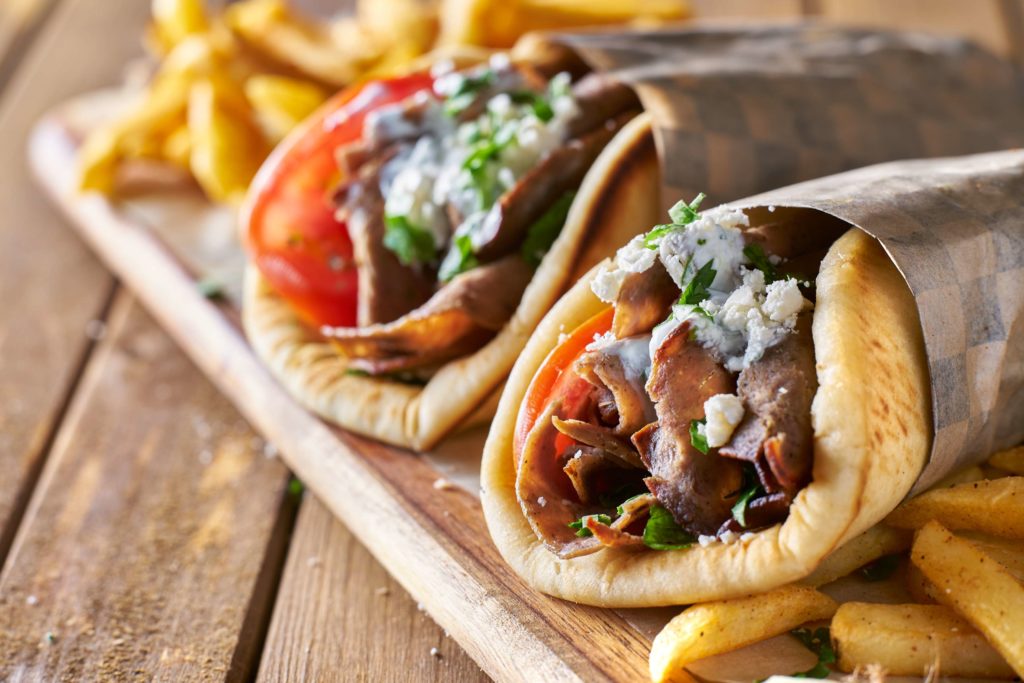
Gyros are an economical meal choice and so yummy! When the meat is roasted vertically and turned on the spit it is known as Gyro. Wait, it is not done yet. Slices of gyro are then placed in a pita with various taste enhancers including sauce, onions, lettuce, tomatoes, and potato chips.
Kalamarakia Tiganita
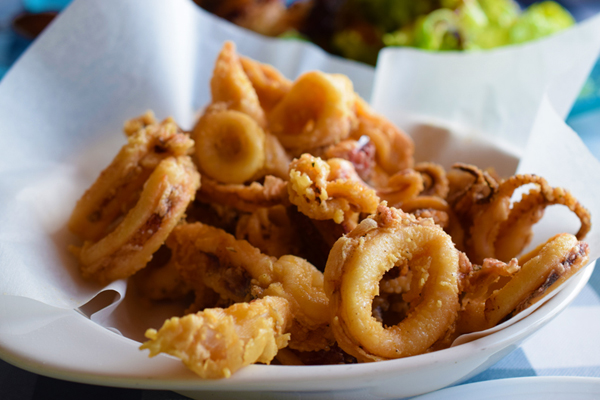
Deep-fried squid served with salt and lemon, and frequently also a sauce on the side. Calamari is a popular appetizer in Greece, that you will find in every taverna. Perfect for light lunch or dinner.
Lavraki
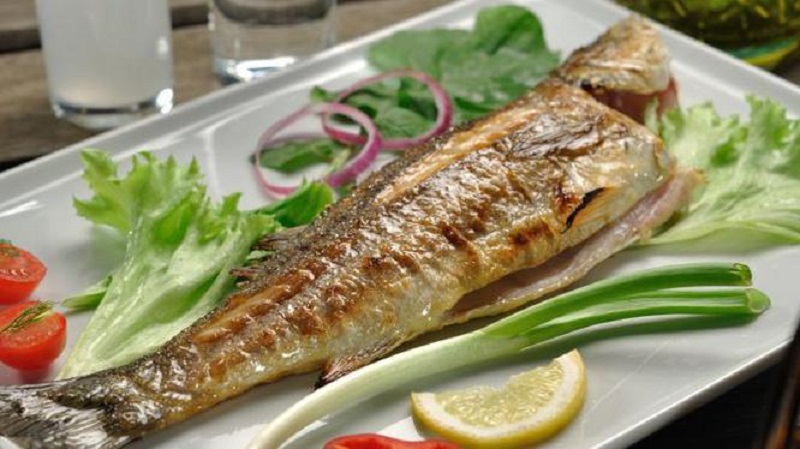
Sea Bass is another traditional Greek food that any fish lover should try while visiting Greece. Grilled, lightly seasoned with herbs, sea salt, and lemon. What can be better?
Kritharaki
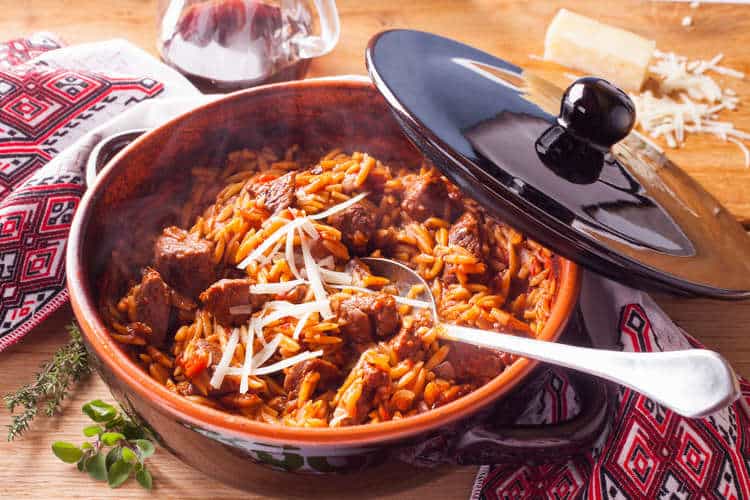
A specific type of Greek Pasta that looks almost like long-grain rice. It’s usually served in tomato sauce or with chicken or nuts, nutmeg, and peas. Kritharaki is also used in the traditional dish Giouvetsi, which is made of Chicken, Lamb, or Beef.
Melomakarona

Greek honey cookies or Melomakarona are the epitome of Christmas and holidays in Greece. They are soft and syrupy, as they are dipped in a spiced cinnamon and orange syrup after they are baked. They also have crushed walnuts sprinkled all over them to add that crunchy texture as well.
In some other variations of the cookies, you can find them filled with chocolate or chestnuts. No matter the type of Melomakarona, you definitely are bound to find some on the Christmas dinner table.
Kourabiethes
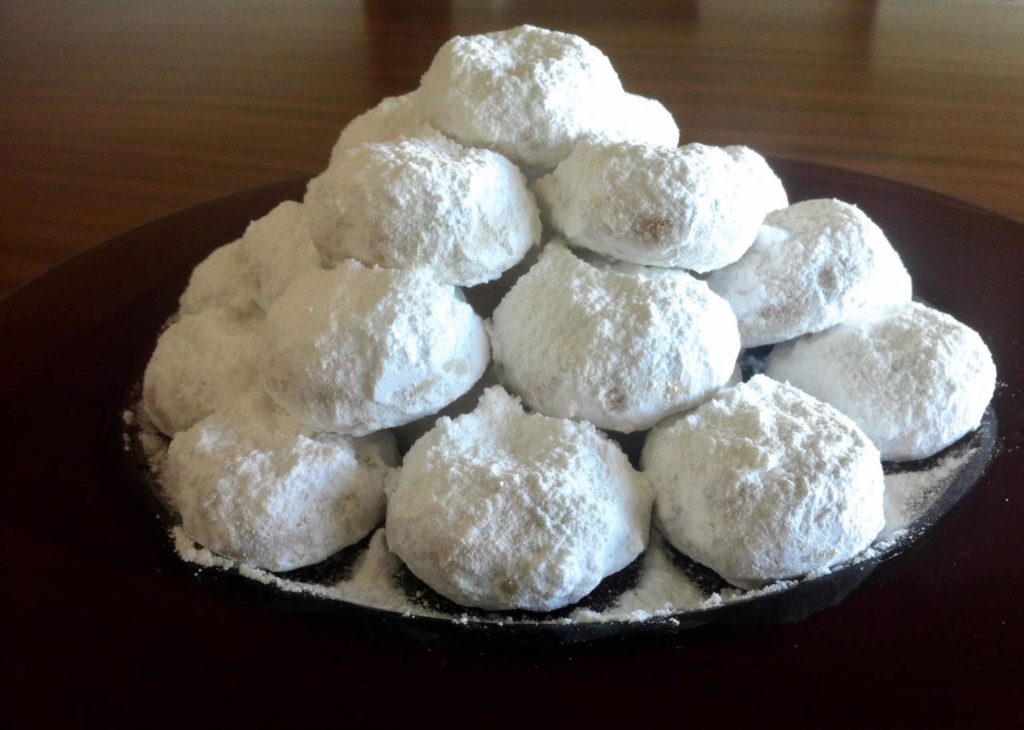
Kourabiethes go hand in hand with Melomakarona, in the sense that you always find them in adjacent platters on the Christmas table. With regards to flavor and look, they are nothing alike. Kourabiethes are almond snowballs made out of flour, almonds, butter, sugar, a splash of almond liqueur, and a tad bit of rosewater.
The “snowball” part comes after they are baked and slightly cooled; that’s when copious amounts of icing sugar are dusted over them. As you might’ve already guessed, there is a debate every year on the Christmas table about which dessert is the best, Melomakarona or Kourabiethes. You’ll have to try them yourself if you want to have input!
Galatopita
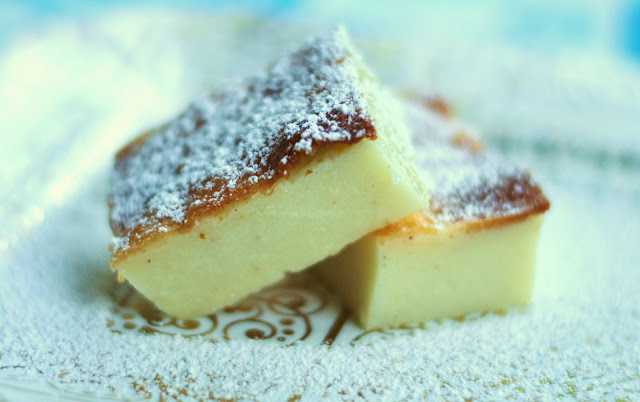
Greek Milk Pie. Among the syrupy desserts, the light galatopita makes its presence known. It’s less sweet than Melomakarona and Kourabiethes for sure, yet still sweet enough to satisfy the dessert craving after a lavish Christmas feast.
The milky interior of the pie made out of butter, sugar, milk, cornstarch, semolina, and eggs is topped by a coat of sugar, lemon zest, water, and egg to make a crunchy overcoat; sort of like the French crème Brûlée. At the end of the day, it’s simple, sweet, delicious, and makes for a very quick dessert served during the festive period.
Karythopita
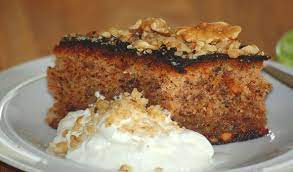
It is a Greek dessert cake made primarily from walnuts and covered in sweet syrup. Its name is a compound word that derives from “karýdia” and “pita”. There are several variations of the dish, with unique ingredients used in both the syrup and cake.
Kalitsounia Kritis
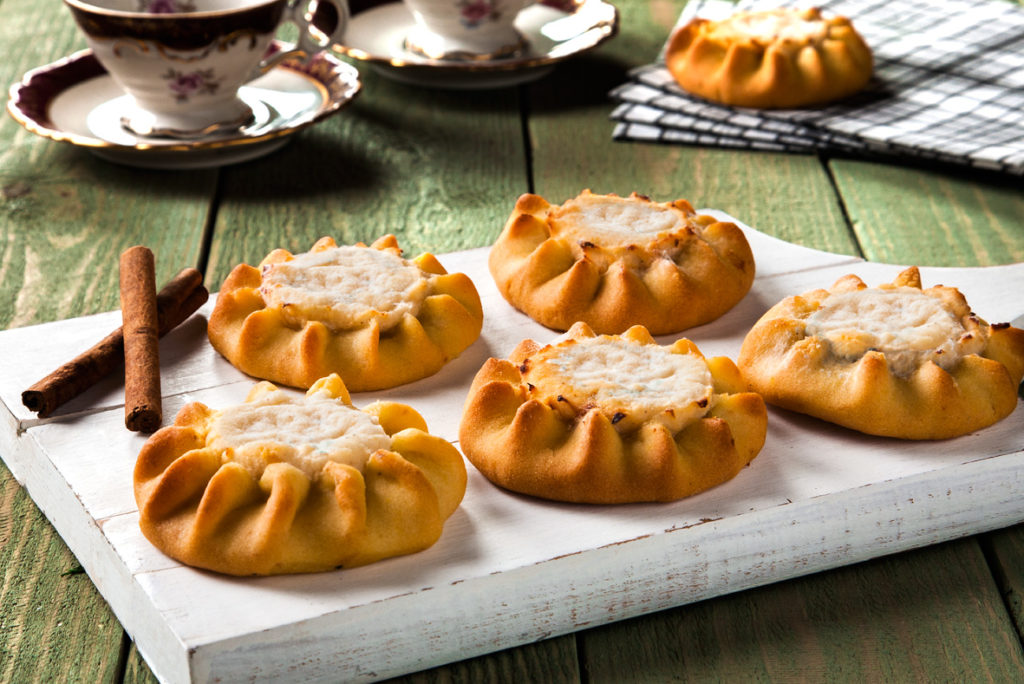
These delicious little cheese pastries are a holiday tradition from the island of Crete, but nowadays they are eaten almost everywhere throughout the year at times of celebration.
Kalitsounia or Lichnarakia are traditionally made with the fresh soft variety of mizithra cheese (not the salty type). Serve as a delicious dessert with a drizzle of warm honey and a sprinkle of powder cinnamon. Extremely soft and highly addictive!
Tsoureki
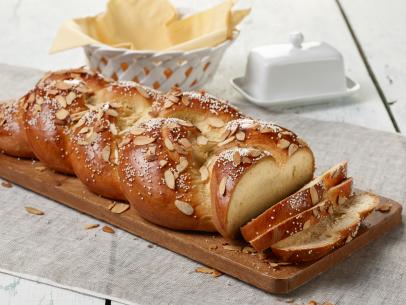
is a sweet holiday bread made with flour, milk, butter, and sugar and commonly seasoned with orange zest, mastic resin, or mahlab. One variation commonly called “Easter bread” is made by Greek communities during Easter, not only in Greece but also in other countries with Greek communities. It is also sometimes called Armenian Easter bread.
Kontosouvli
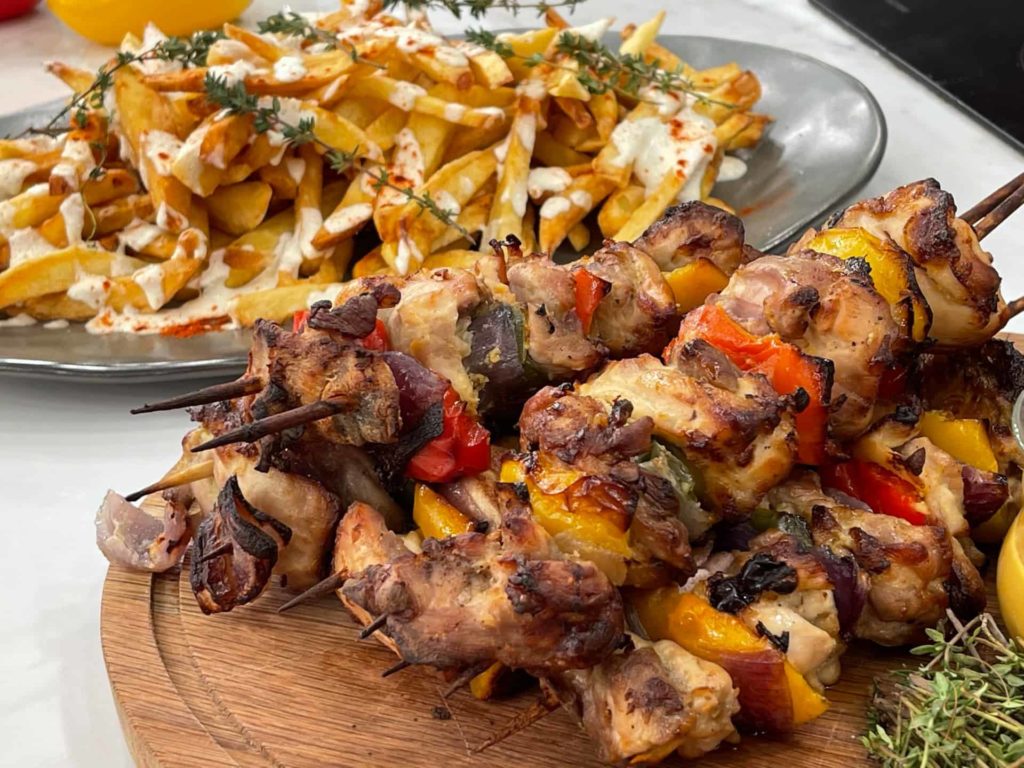
Kontosouvli is an extra-large pork souvlaki traditionally slow-roasted on a spit over an open charcoal pit. It’s always a season in Greece to enjoy this juicy, crunchy, meaty delight.
Spanakorizo
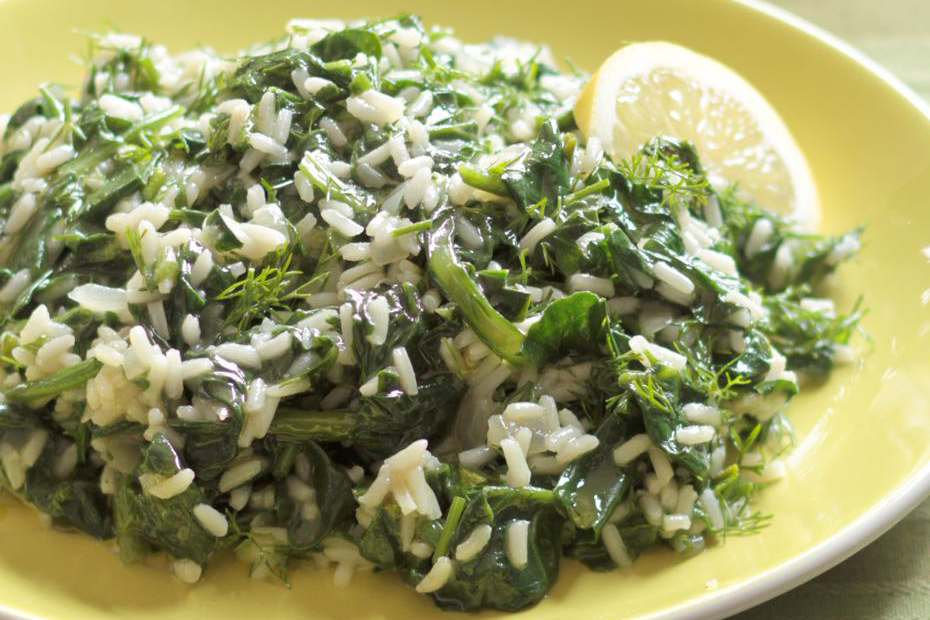
In its simplest form, Spanakorizo consists of rice and spinach that are slowly simmered until creamy and well combined. The dish is usually generously seasoned with lemon juice and olive oil and is easily adapted with additional ingredients such as spring onions, chickpeas, leeks, and a variety of herbs and spices.
It is traditionally prepared during Lent but is commonly enjoyed all year round as a healthy main course, when it is typically accompanied by feta, or as an accompaniment to various meat or seafood
Dakos
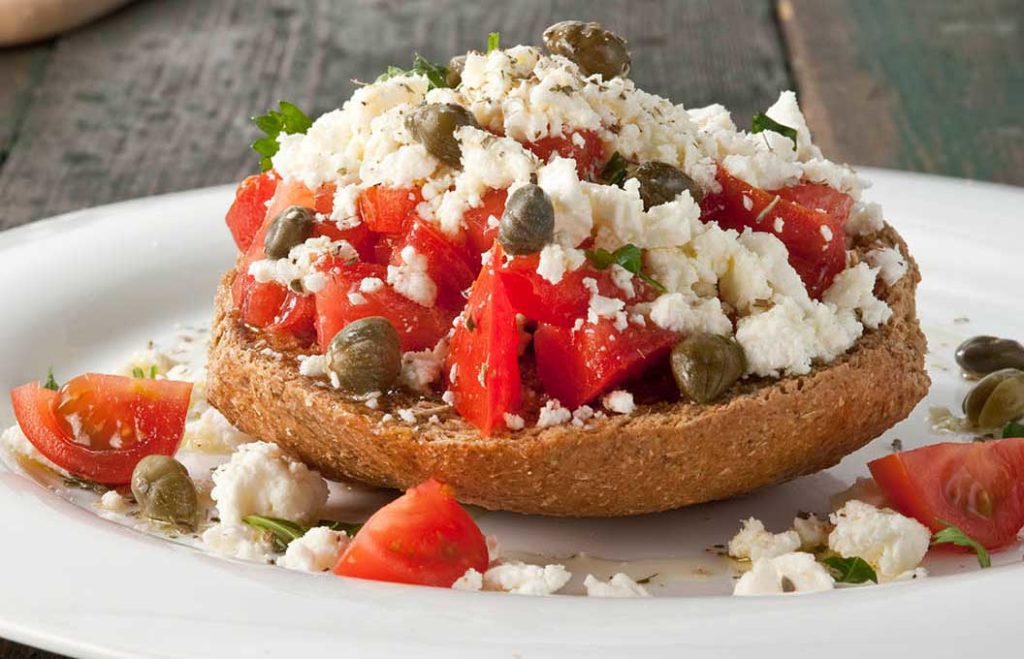
Cretan Salad. This authentic Cretan Salad includes crunchy barley rusk soaked in olive oil and topped with tomato and cheese.
Kalamata olives
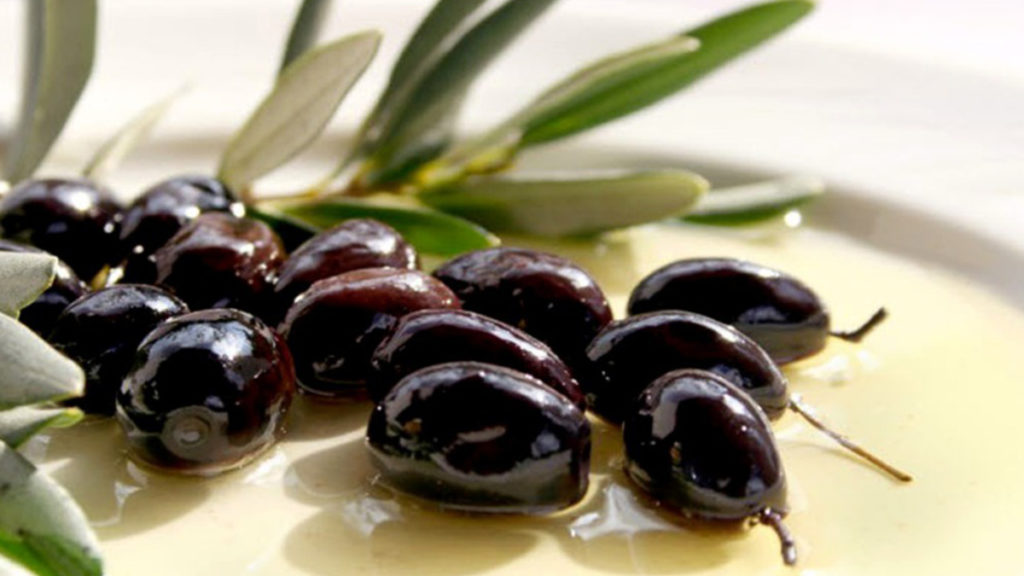
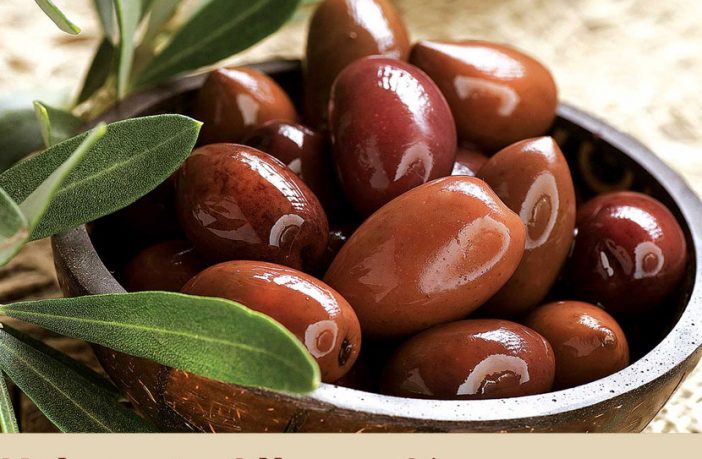
You may have thought that black olives are those watery things in cans that absolutely have no flavor. Kalamata olives have a fruity and rich flavor, and they are addictive! And because they are processed naturally (without lye) they are much richer in antioxidants compared to California and Spanish style.
Koulouri
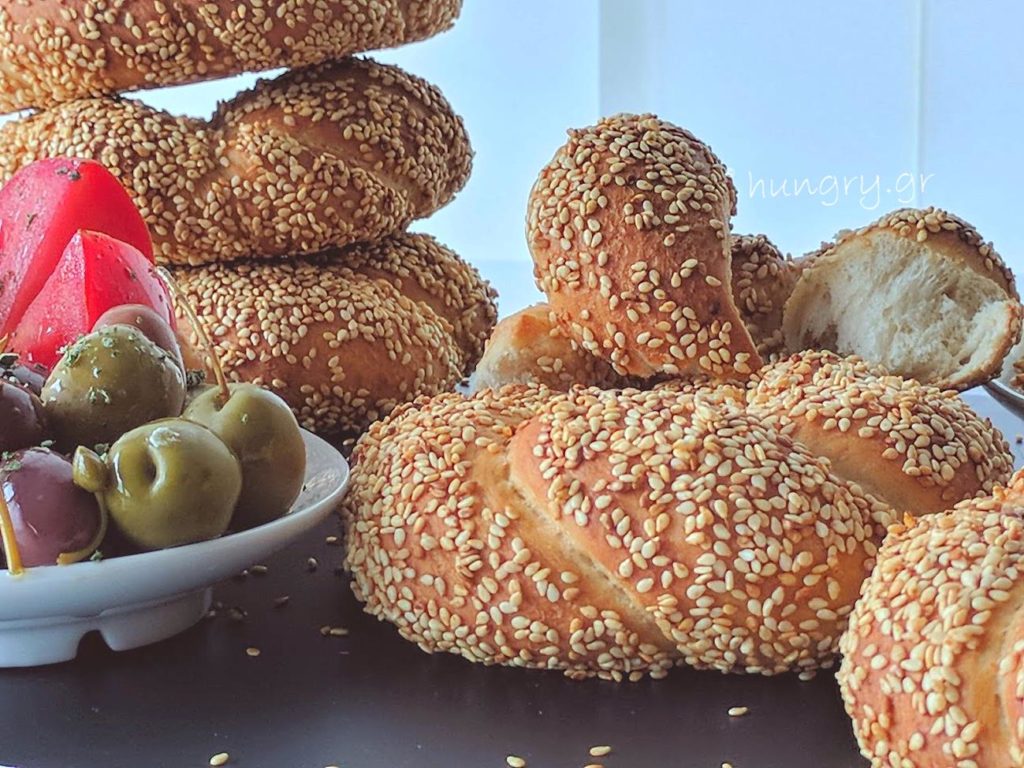
Simit is a circular bread, typically encrusted with sesame seeds or, less commonly, poppy, flax, or sunflower seeds, found across the cuisines of the former Ottoman Empire, and the Middle East. Simit’s size, crunch, chewiness, and other characteristics vary slightly by region. It is widely known as Turkish bagel in the United States
Rizogalo
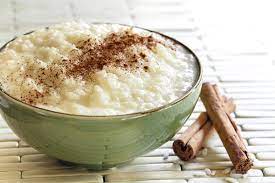
Rizogalo is the Greek version of rice pudding. It’s one of those dishes that has infinite variations around the globe and each one manages to taste completely different. In Greece, rizogalo is prepared by combining glutinous sticky rice, water, heavy cream, cardamom, cinnamon sticks, and sugar.
It’s topped with more ground cinnamon and is usually served cold in a glass bowl. In some regions in the northeast, drops of delicate rosewater are poured over the dessert, confirming its Turkish roots. It’s considered to be a refreshing summer treat.
Moschari kokkinisto me kritharaki
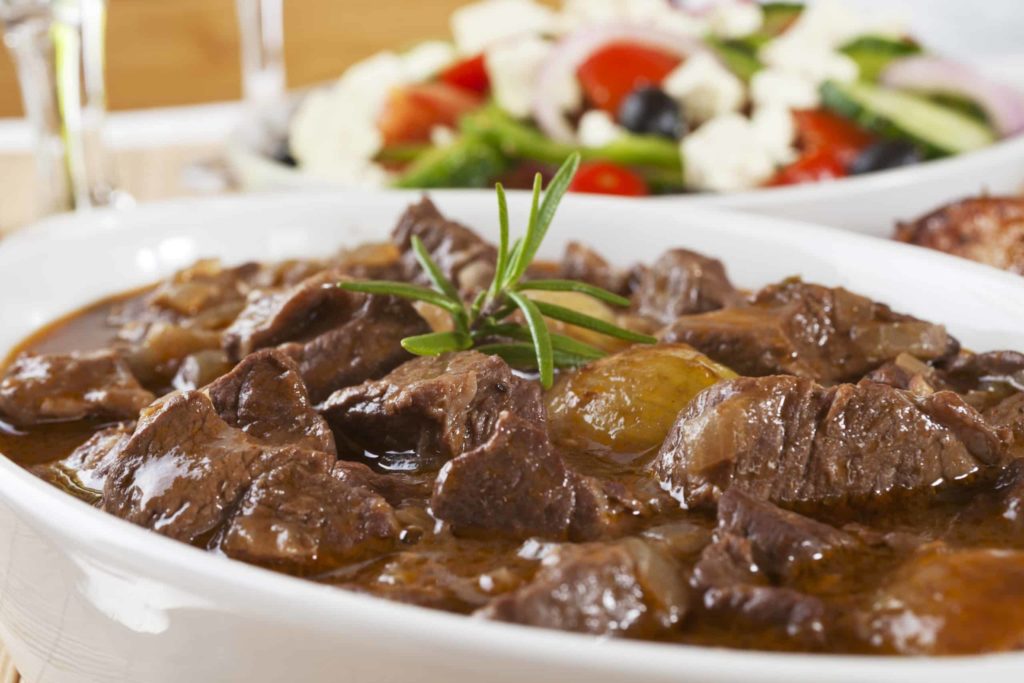
Moschari Kokkinisto me Kritharaki is a Greek dish made with stewed veal and orzo pasta is cooked in the sauce. Although this dish is usually cooked with veal, it can also be made with beef or buffalo meat, lamb, pork, rabbit, or chicken. The veal is cooked in a tomato sauce and the cooking time differs for each kind of meat. After the meat is cooked the pasta (usually orzo, hilopites or another type of small pasta) is added and cooked in the sauce.
Spetzofai
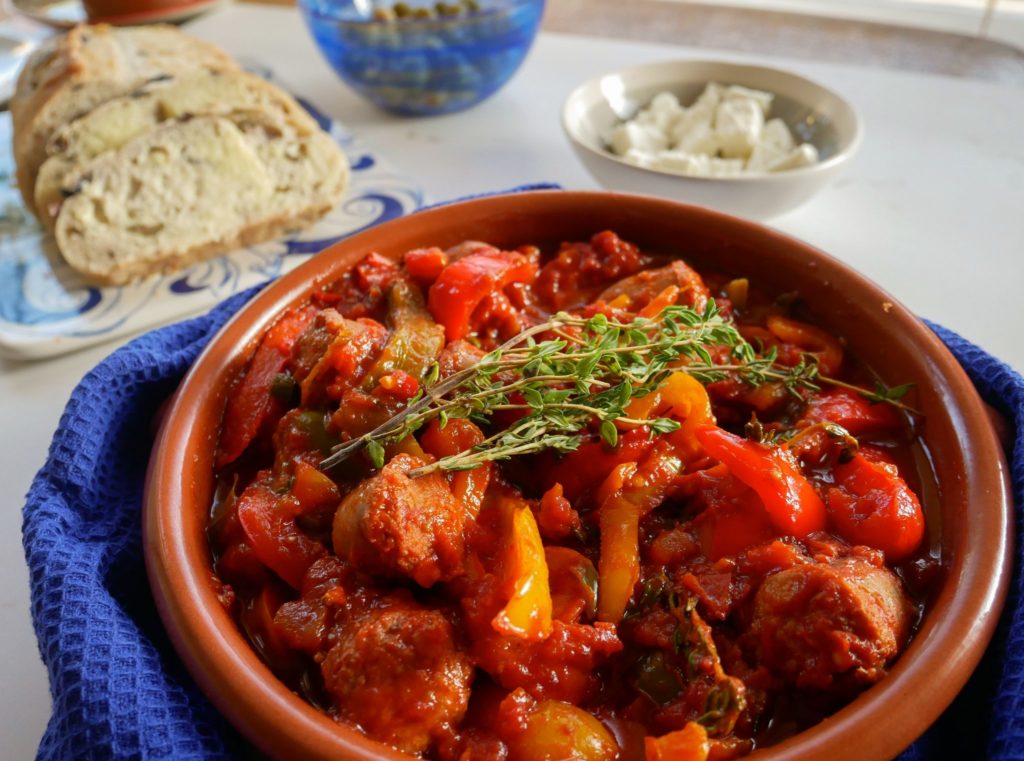
A rustic spicy Greek dish made with thick country sausages and peppers in a rich tomato sauce.. Spetsofai is a Greek dish, one can find in many variations. The famous spetsofai from Pelio contains aubergines, while in most areas, it is prepared with green or multicolored mild bell peppers, or spicy peppers hot enough to make your eyes tear! Perfect over a glass of red wine or tsipouro! Paired with salty kefalotyri cheese or tangy feta, lots of crusty bread, to dig in all the delicious sauce, it is guaranteed to warm you up during the cold winter days.
Galeos skordalia
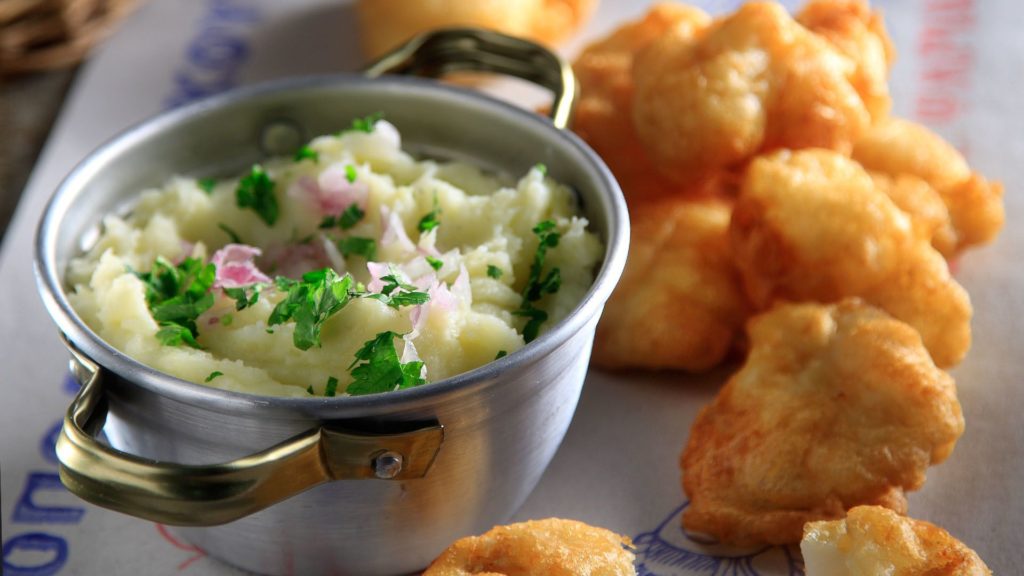
Galeos (tope shark) are found around the coast of the Mediterranean. The genus Galeorhinus galeus is derived from the Greek words “galeos” meaning a shark and “rhinos” which means nose. The traditional way of cooking galeos in Greece is deep frying the fish and serving it with Skordalia. This would be a delicious dish for winter but with too many calories and not for diet. Being on the Mediterranean Diet, I have been trying to incorporate more fish in our diet and have been trying new ways of cooking them healthier, so marinating it and baking it makes a much lighter and healthy meal.
Paidakia
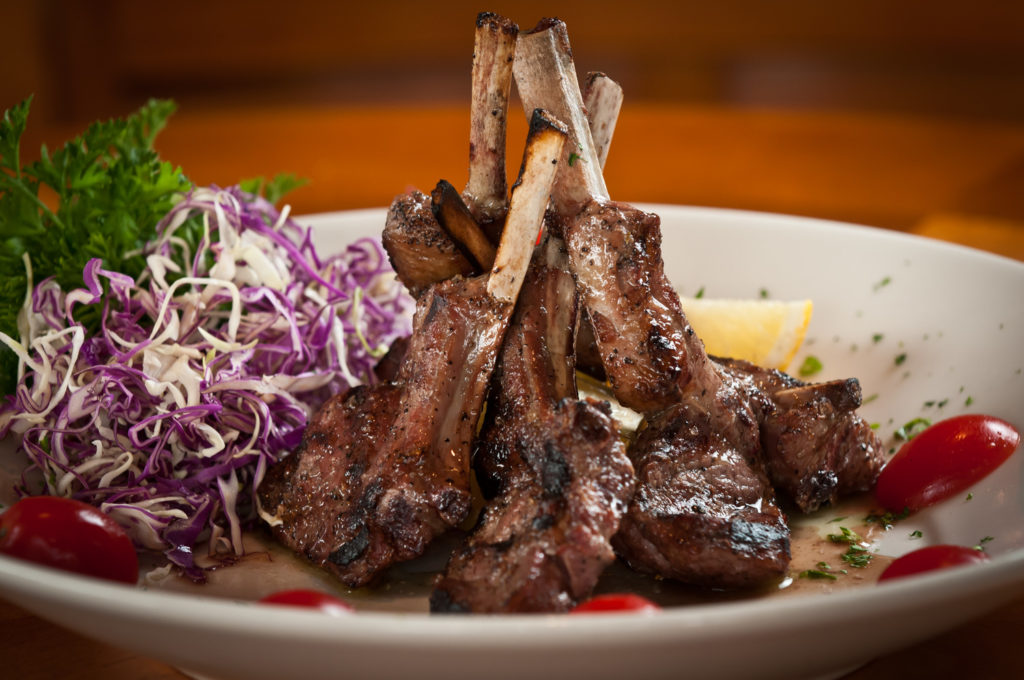
the lamb to be cut into small rib chops, called “paidakia” also called “Greek lamb chops”. A rack of lamb is the entire set of ribs (usually 8), and these small ribs (paidakia) can be purchased and served “single cut” (with one rib bone) or “double cut” when too small. Of course, the best option is to grill the paidakia (Greek lamb chops) on a charcoal barbecue, to get them all crispy and smokey. However, they also work great on a grill pan or in the oven if you don’t have the time or space for a proper barbecue. Traditionally Greek lamb chops are marinated in olive oil, mustard, fresh thyme, garlic, lemon zest, and peppercorn. Seasoned with salt and fresh ground pepper and finished with a last-minute squeeze of lemon and dried Greek oregano. Simply delicious!
Melitzanosalata
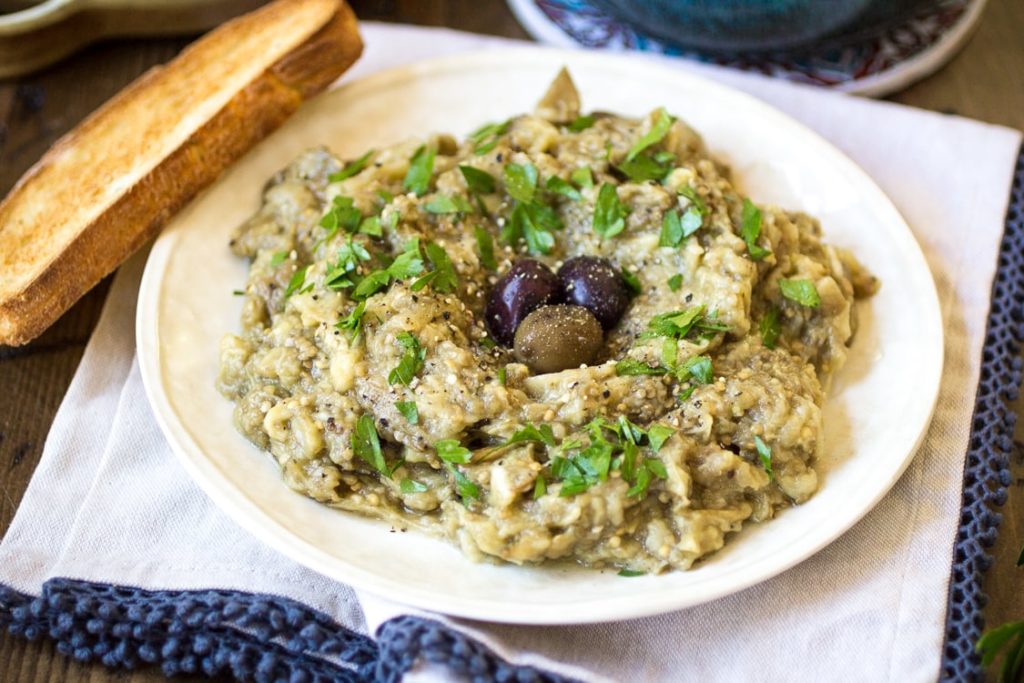
Melitzanosalata is a simple, rustic Greek eggplant dip made with roasted, perfectly smoky eggplant with garlic, parsley, red onions, lemon juice and extra virgin olive oil.
Kreatopita
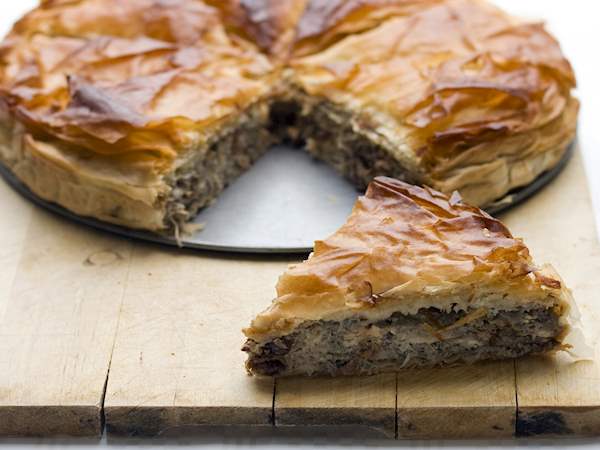
This traditional Greek meat pie combines flaky phyllo dough with a flavorful ground meat filling. Since it is eaten across the country, Kreatopita appears in numerous versions that often vary in shape and adapt the filling with rice, leeks, cheese, béchamel sauce, and various herbs and seasonings.
Regardless of the abundant varieties, they can all be enjoyed as a filling main course, snack, or even as a convenient street food option.
Fasolakia Lathera
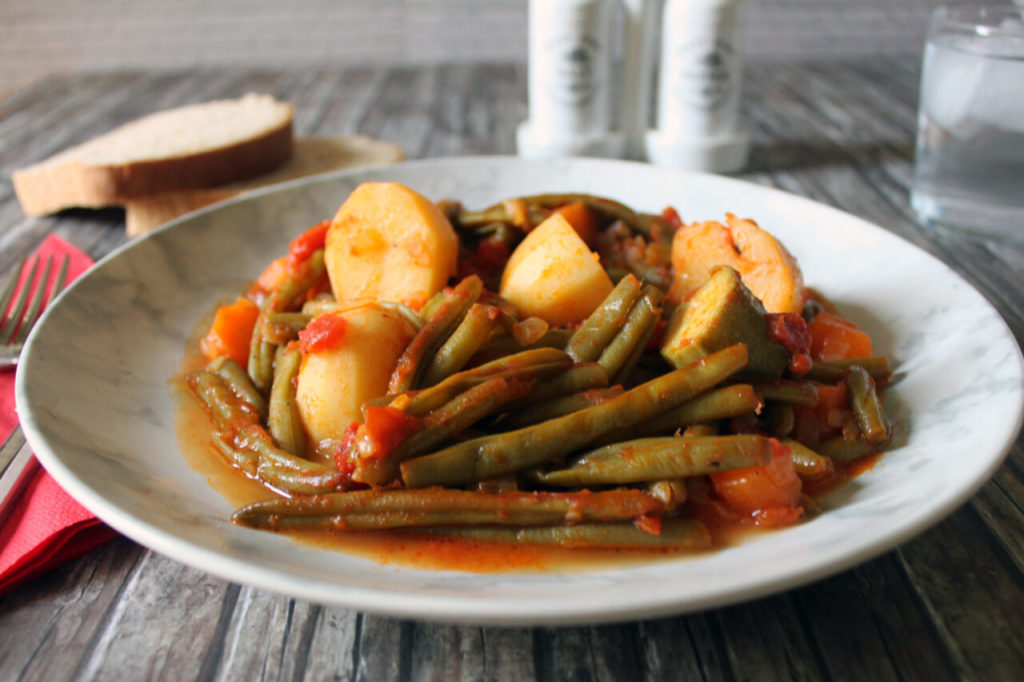
The original recipe for Greek green beans – smooth and velvety green beans with potatoes stewed in tomato, herbs, and olive oil. They will melt in your mouth! Perfect as a vegetarian main course or a side dish.
Revithia
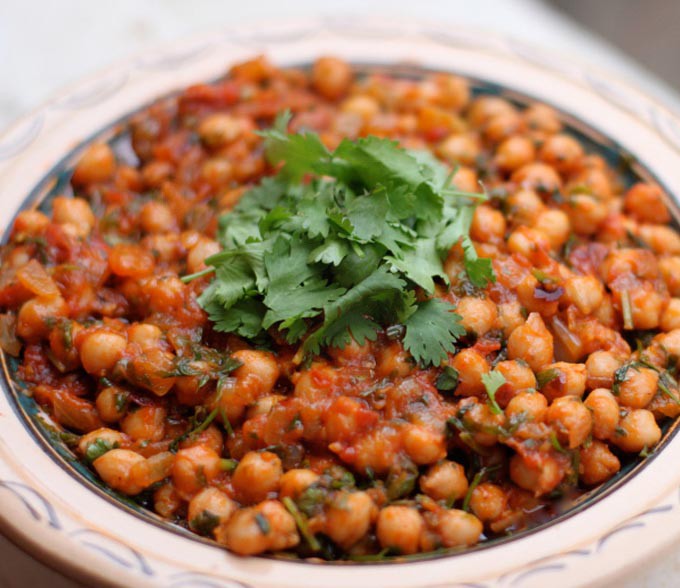
This thick and nutritious chickpea soup is a Greek classic that is enjoyed throughout the country, but is traditionally associated with the island of Sifnos, where it comes in a form of a thick, oven-cooked stew. Revithia varies in consistency and additional ingredients, but it is often enriched with lemon and olive oil that give the dish its specific, tangy flavor. It is usually enjoyed warm, served drizzled with olive oil, and accompanied by bread.
Diples
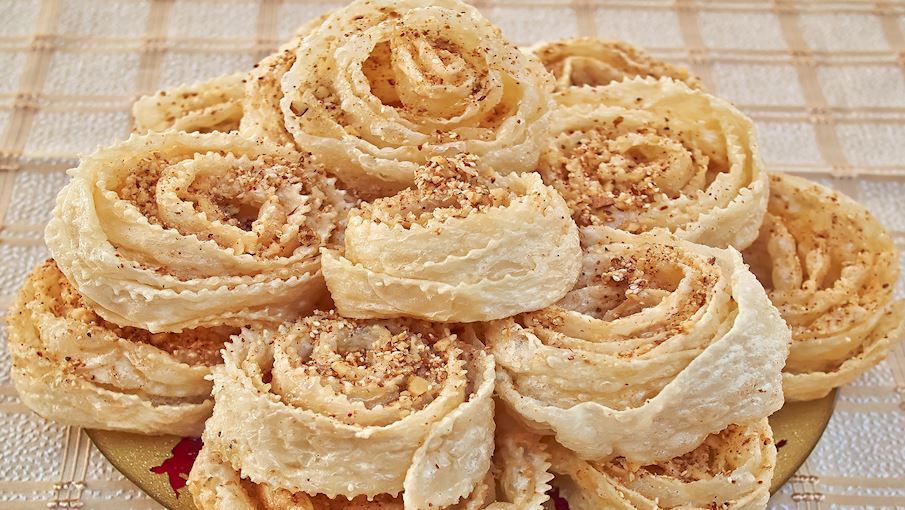
This delicious Greek dessert consists of thin pastry sheets that are rolled, deep-fried, and doused or drizzled with a thick, honey-based syrup. These pastries can be wrapped into various shapes and are often sprinkled with nuts and dusted with cinnamon. Especially popular on the island of Peloponnese, they are a Greek classic that is usually prepared on special occasions.
Kolokithopita
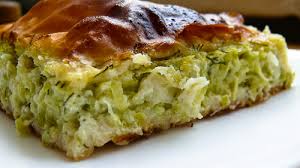
The traditional version of this savory Greek pie employs a flavorful zucchini and feta filling which is placed between two layers of phyllo pastry, usually the homemade type that is slightly thicker than the store-bought varieties. Similar versions of Kolokithopita can be layered or prepared without the crust, while the filling can be adapted with additional ingredients and zucchinis can be replaced with winter squash.
The pie comes in numerous shapes and sizes, and it can be enjoyed as a snack, an appetizer, or a light main course. The varieties prepared with winter squash are occasionally transformed into desserts, in which feta is left out, and the pie is doused in sugar syrup.
Fava
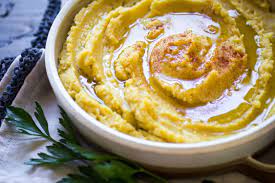
Though it only uses a few ingredients, Greek fava dip is an incredibly flavorful dish. It consists of yellow split peas that are cooked alongside onions and various spices until they completely disintegrate and transform into a creamy, velvety purée.
It is believed that the name of the dish stems from the Latin word favus, meaning broad beans or fava beans, though they are never used in the production of this creamy dip. Fava is found in numerous taverns throughout the country, and it is usually enjoyed as a meze dish, traditionally served topped with diced onions and a drizzle of olive oil.
Biftekia
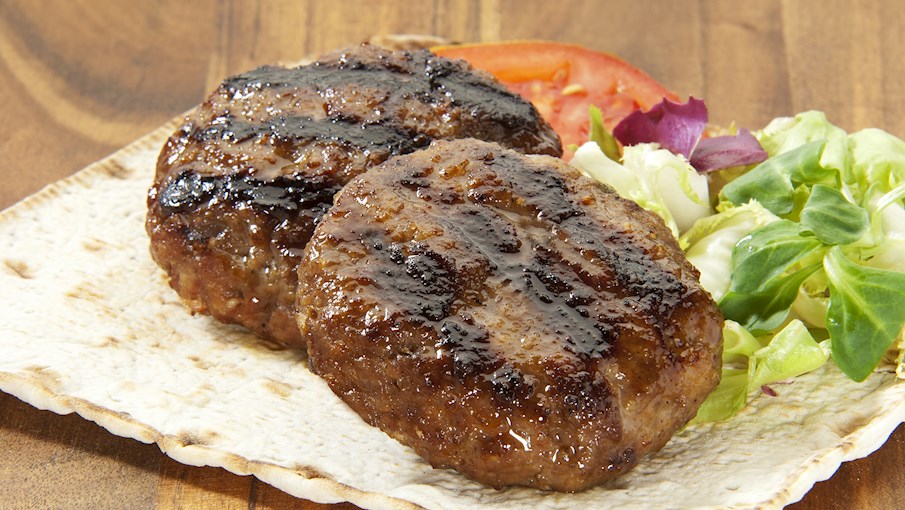
It is a traditional Greek dish that’s often described as a cross between burger patties and slightly flattened meatballs. The patties are made with a combination of ground pork, beef, or lamb, and the meat is mixed with onions, breadcrumbs, eggs, and aromatic herbs such as mint and oregano.
Once shaped, the Biftekia are usually fried in hot oil until they’re fully cooked, but they can also be grilled. When served, these meat patties are typically accompanied by fries, red onions, or cooked vegetables. The dish is especially popular during summer as a barbecue staple.
BONUS



